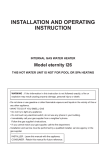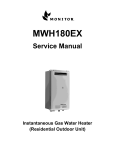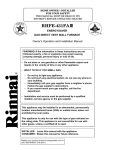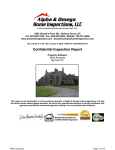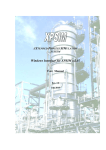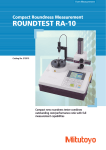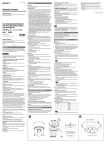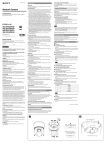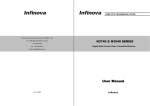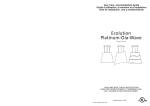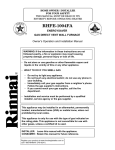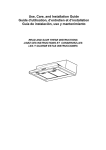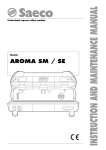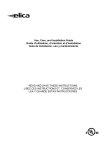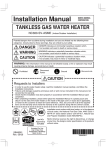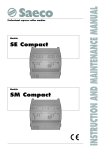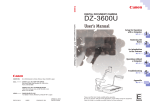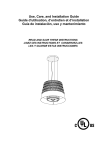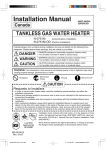Download MWH180 - Monitor Products
Transcript
MWH180 Service Manual Instantaneous Gas Water Heater (Residential Indoor Unit) Table of Contents 1. General Outline of Appliance 1-1 1-2 1-3 1-4 1-5 1-6 1-7 2. Installation and Related Work 2-1 2-2 2-3 2-4 2-5 2-6 2-7 2-8 2-9 2-10 2-11 2-12 2-13 2-14 2-15 2-16 2-17 2-18 3. Features .......................................................................................................................................... 1 Specifications ................................................................................................................................. 2 Performance ................................................................................................................................... 3 General Construction (Parts Names) ............................................................................................. 4 Main Component Structures ........................................................................................................... 5 Main Safety Devices ....................................................................................................................... 9 Scale Build Up Alarm .................................................................................................................... 10 INSTALLATION INSTRUCTIONS ................................................................................................. 11 DIMENSIONS ............................................................................................................................... 15 TEMPLATE OF L TERMINATION INSTALLATION ...................................................................... 16 SUGGESTED PIPING-BASIC INSTALLATION ............................................................................ 17 SUGGESTED PIPING-CIRCULATION SYSTEMS ....................................................................... 18 VENT PIPE INSTALLATION ......................................................................................................... 19 GAS LINE SIZING CHARTS ........................................................................................................ 35 GAS PIPING ................................................................................................................................. 36 WATER PIPING ............................................................................................................................ 36 PRESSURE RELIEF VALVE ........................................................................................................ 37 ELECTRICAL CONNECTION ...................................................................................................... 37 WIRING DIAGRAM ....................................................................................................................... 39 DIAGNOSTIC POINTS ................................................................................................................. 41 SCHEMATIC DIAGRAM ............................................................................................................... 42 WIRING REMOTE CONTROLLER ............................................................................................... 43 MAIN REMOTE CONTROLLER CMR-2250 (P/N 3748) .............................................................. 44 BATH REMOTE CONTROLLER YST-2250 (P/N 3749) ................................................................ 45 TESTING OPERATION ................................................................................................................ 46 Service and Maintenance 3-1 3-2 3-3 3-4 3-5 3-6 3-7 3-8 3-9 3-10 3-11 Operation Principles ..................................................................................................................... 47 Time Charts .................................................................................................................................. 48 Flow Charts .................................................................................................................................. 50 Fault Findings and Error Code ...................................................................................................... 51 Gas Setting Procedure ................................................................................................................. 54 Combustion Specification, Various Combination Setting .............................................................. 55 Remote Controllers Special Features ........................................................................................... 57 Disassembling/Assembling Parts ................................................................................................. 59 Procedure for Flushing Water Heater ........................................................................................... 69 Exploded View .............................................................................................................................. 72 Parts List ....................................................................................................................................... 74 1. General Outline of Appliance 1-1 Features 1. High-performance & high-capacity water heater features • Stable heating and supplying from 0.58 to 5.8 GPM with the proven temperature control method combining the feed forward, feedback and water flow control • Design to reduce water temperature drops to hold temperature variation upon re-feeding • Maximum flow rate of 5.8 GPM (22 L/min) allowing simultaneous hot water supply for the kitchen and shower 2. Environmently-conscious and low NOx exhaust • The rich-lean design of the combustion burners allows the value of NOx to be as lower than 55 ppm or less 3. Self-diagnostic function • Detects the scale-clogging of the heat exchanger assembly (warning) • Detects the blocked exhaust system (alarming) 4. Improved reliability • The potted PCB (Printed Circuit Board) and connectors equipped with retainers have greatly improved the reliability of the electronic components. 5. Easier installation work • The slide-type wall hanging frame is provided so that the intake pipe and exhaust pipe can be aligned during the installation. 6. The PCB has a function to let the LED flash upon heater trouble and the remote controller has an error-display function. 7. With ultra-low power consumption, the optional remote controllers have highly visible display (equipped with a backlight). The main remote controller and the bath remote controller are different in design. -1- 1-2 Specifications Type of appliance Model number Installation Type of Hot water supply Exhaust system Power supply Ignition system Outer panel material Hot water capacity (water temp. +25°C rise) Maximum hot water capacity (54°F rise) Maximum water supply pressure Recommended minimum water supply pressure Minimum operational water flow Gas continuous flow water heater MWH-180 Indoor only Wall hanging End stop system Direct vent forced combustion (FF type) Appliance AC120V 60Hz Remote controller DC12V (digital) Direct electronic ignition Pre-Painted Galvanized Steel Sheet 0.58 ~ 5.8 GPM 5.8 GPM 150PSI (1.0MPa) 15PSI (recommended 25-75 psi for maximum performance) 0.58GPM (2.2L/min) Normal 61W Electrical comsumption Standby Main/Bath remote controller on 3.7 W Anti-frost heater operation 84W R3/4NPT Gas R3/4NPT Connections Water inlet R3/4NPT Hot water outlet below 480°F Exhaust temperature 49dB Noise level 55ppm Max. NOx Flame failure - Flame rod, Over heat switch 212°F, Over heat limit 203°F Safety devices Thermal fuse for heat exchanger 363°F, Over current - fuse (5A) Automatic frost protection, Combustion fan motor rpm check - PCB Dimensions Height 24 1/32" (610mm) Width 13 25/32" (350mm) Depth 8 3/8" (210mm) Weight 43lbs. (20kg) Main remote controller 96 - 140°F Temperrature Range Bath remote controller 96 - 140°F Available Default Temperatures 110°F, 120°F, 140°F, 165°F (without remote controller) (set by Dip switch on PCB) Maximum 180,000Btu/h Minimum (reference) Natural Gas (52.7kW) 20,000Btu/h (6.0kW) Gas consumption Maximum 180,000Btu/h Minimum (reference) Propane Gas (52.7kW) 20,000Btu/h (6.0kW) CMR-2250 (P/N3748) Main control kitchen / laundry Remote controller (option) YST-2250 (P/N3749) Bathroom control Remote controller cable (option) Nonpolarized two core cable Top of heater 12" (30.5cm) Front of heater 6" (15.2cm) Sides of heater 2" (5.1cm) Clearance from combustibles Back of heater 0" (0cm) Floor 12" (30.5cm) Vent pipe 0" (0cm) Carton box dimensions Height 31 1/2" (800mm) Width 15 7/8" (403mm ) Depth 11 1/32" (280mm) -2- 1-3 Performance Performance-Capacity characteristic curves 8.0 7.0 Water flow rate [GPM] 6.0 Inlet water temperature 41°F (5°C) 50°F (10°C) 59°F (15°C) 68°F (20°C) 77°F (25°C) 5.8 GPM 5.0 4.0 3.0 2.0 1.0 0.5 0.58 GPM 96 95 100 110 120 130 140 150 160 165 Hot water temperature [°F] With water temperature 50°F (10°C) at inlet 8.0 8.0 7.0 7.0 Water flow rate [GPM] Water flow rate [GPM] With water temperature 41°F (5°C) at inlet 6.0 5.0 4.0 3.0 2.0 1.0 0.5 110 120 130 140 Hot water temperature [°F] 150 160 165 Water flow rate [GPM] Water flow rate [GPM] 4.0 3.0 2.0 0.58 GPM 110 120 130 140 Hot water temperature [°F] 150 160 165 110 120 130 140 Hot water temperature [°F] 150 160 165 8.0 7.0 5.8GPM 5.0 4.0 3.0 2.0 0.58 GPM 110 120 130 140 Hot water temperature [°F] 150 5.8GPM 5.0 4.0 3.0 2.0 0.58 GPM 96 95 100 With water temperature 77°F (25°C) at inlet 96 95 100 6.0 1.0 0.5 0.58 GPM 96 95 100 Water flow rate [GPM] 2.0 7.0 5.8GPM 5.0 1.0 0.5 3.0 8.0 7.0 6.0 4.0 With water temperature 68°F (20°C) at inlet 8.0 1.0 0.5 5.8GPM 96 95 100 With water temperature 59°F (15°C) at inlet 6.0 5.0 1.0 0.5 0.58 GPM 96 95 100 6.0 160 165 -3- 110 120 130 140 Hot water temperature [°F] 150 160 165 1-4 General Construction (Parts Names) 3 16 4 1 2 23 12 14 27 15 9 18 29 26 30 19 28 17 6 8 7 5 31 13 24 11 No. 1 2 3 4 5 25 10 Description Front Panel Casing Assembly Exhaust Gas Duct Air Inlet Box Assembly Modulation Valve Unit (Gas Control Assembly) 6 Manifold Assembly 7 PCB Unit 8 Surge Protector 9 Igniter Transformer 10 Water Inlet 11 Hot Water Outlet 21 No. 12 13 14 15 16 17 18 19 20 21 22 22 20 Description No. Description Heat Exchanger Thermistor 23 Exhaust Chamber Outgoing Water Thermistor 24 Water Filter Assembly Thermal Fuse Device 25 Drain Plug Heat Exchanger 26 Flame Rod Over Heat Switch 27 Frost Sencing Switch (bi-metal switch) (bi-metal switch) Combustion Fan Motor Assembly 28 Electrode Combustion Chamber Assembly 29 Transformer(100V) Burner Assembly 30 Fuse(3.15A) Gas Inlet 31 Fuse(5A) Water Flow Sensor Water Flow Control Device -4- 1-5 Main Component Structures 1. Gas flow control device • Feeds the necessary amount of gas to heat water to a set temperature, based on the amount of water flowing in through the inlet measured by the water flow sensor and the water temperature calculation. • When the thermistor detects the water temperature at the inlet, the temperature is compared with the setting. An electric current representing the temperature difference is transmitted to the PCB where the current is amplified and dispatched to the Modulating Solenoid Valve. • An electromagnetic force caused by the current from the PCB pushes the plunger upward. <Upward force> • Pressure received at the diaphragm due to internal pressure in the chamber of the Modulating Solenoid Valve pushes the plunger downward. <Downward force> • The plunger stops moving and stays at a certain position when the Upward and Downward force are balanced. • As the plunger remains at the position, the valve position of the Modulating Solenoid Valve linked to the plunger is determined. This determines a "clearance" between the valve body and the Modulating Solenoid Valve, establishing a necessary gas quantity. The required amount of gas is then supplied to the main burner. • If the temperature of the heated water is lower or higher than the setting, the resistance of the hot water temperature detecting thermistor changes accordingly to automatically adjust the gas amount by changing greater or lower the current transmitted to the Modulating Solenoid Valve. This stabilizes the heated water temperature. • When the gas supply pressure is changed, the receiving pressure of the diaphragm changes and also changes the clearance between the valve body and the Modulating Solenoid Valve. The gas is controlled to remain at a constant level. -5- 82 21 21 OUT 2 10 20 Diaphragm OUT1 Feed back air connection Coil 127.7 LP 13A 96.5 Plunger Plunger spring Feed back air connection UP34-38 LNG 6B00001 Pressure check hole Solenoid Valve Modulating Solenoid Valve Filter IN -6- 2. Water flow sensor * Measures the water flow as its rotor (bladed wheel) spins with the passing water. The rotation of the rotor is detected by the sensor rotor (blade equipped with a magnet) of the wheel and the Hall element which calculates the water quantity. ø30 Sealant Hall element IC 50 150 ± 20 Main body Rotor ø30 Inlet 3. Water flow control device 50 29.5 35 Wa t e r f l ow c o n t r o l d ev i c e m o t o r Va l ve b o d y Va l ve m a i n b o d y 28.5 * When water flows more than water heater capacity, hot water temperature becomes lower than the setting. The water flow control device automatically reduces the water flow to prevent such temperature drops. If the water flow is greater than the heater capacity, a signal from the PCB activates the water flow control device's motor (stepping motor). In response to this operation, the valve body of the water flow control device also is operated to reduce the water flow by narrowing the water path. Water flow fluctuations are detected and transmitted to the PCB by the water flow sensor. When the appropriate level of water flow is reached, the PCB signals the motor to stop. Thus, the water flow remains at this level. ø30 -7- 4. Combustion control of rich and lean burners 1) Ignition start After the Main Gas Solenoid Valve, Gas Solenoid Valve 1, Gas Solenoid Valve 2 open respectively as required, the Gas Modulating Solenoid Valve, being held at the slow ignition position (with gas supply at a constant rate), operates to ignite rich burners and lean burners. 2) During combustion When a heating capacity higher than a certain level (approximately 95,000 BTU) is required, both Gas Solenoid Valve 1 and Gas Solenoid Valve 2 are opened to burn with rich and lean burners while the gas supply is controlled by the Gas Solenoid Valve. When the required heating capacity becomes lower than a certain level (approximately 110,000 BTU), the Gas Solenoid Valve 2 is closed while Gas Solenoid Valve 1 remains open to combust with 12 rich burners, with the gas supply controlled by the Gas Modulating Solenoid Valve. Electrode Flame rod Main burner Gas Solenoid Valve 2 Combustion fan Gas Solenoid Valve 1 Gas Modulating Solenoid Valve Main Gas Solenoid Valve Gas -8- 1-6 Main Safety Devices 1. Water flow sensor (Boil-dry protection) When the water flow sensor detects the flow rate set for starting ignition (ignition water flow) or higher, the water heater starts operation. Ignition water flow: 0.71 GPM (2.7 L/min.) Extinction water flow: 0.58 GPM (2.2 L/min.) 2. Flame rod (Flame failure detection) Electric signals are transmitted to the flame detection circuit to confirm the normal combustion when the flame rod detects the rectification of normal combustion flame. Therefore, if the combustion of the burners is not normal, the signals are not sent via the flame rod. The gas control assemblies are closed without the signals and the error code "111" or "121" is displayed on the remote controllers. (Normal with 0.8 µA or higher) 3. Thermal fuse (Over-temperature protection system) The thermal fuse is placed around the heat exchanger assembly. If the ambient temperature inside the water heater becomes extremely high, the fuse will melt down to break the power circuit. In such a case, as no power is supplied to the gas control assemblies, the gas supply is stopped and the combustion is stopped. (The system is activated to blow the fuse at 363°F [184°C].) 4. Over heat switch (residual) Even if the heat exchanger assembly is over heated by no-water combustion, every gas path is closed to avoid risks. At this time, the error code "141" is displayed on the remote controllers. (The switch is provided with a auto-restoration function and turns OFF at 212°F [100°C].) 5. Fan revolution detection device (Hall IC) The device detects the fan revolution speed to control the air supply necessary for normal combustion. If the fan revolution is out of the preset standard range, the gas control assemblies are closed to stop the combustion before combustion failure occurs. In this case, the error code "611" is displayed on the remote controllers. 6. Anti-freeze system (Frost sensing switch and heater) To prevent freezing in the hot water supply circuit, anti-frost heaters are provided at major points of water flow paths in the unit. The heaters are activated by the thermistors in the unit. The 4 heaters, one located on the front side of heat exchanger is 48W, the water supply pipe is 16W, the connection of water inlet is 10W and the connection of hot water outlet is 10W. In order to keep the heat is the most vulnerable part of heat exchanger, the big capacity 48W heater is mounted. (The system turns ON at 37°F [3°C] and OFF at 55°F [13°C].) -9- 1-7 Scale Build Up Alarm Summary The temperature of residual hot water becoms higher as scale starts to build up inside the heat exchanger. The extent of scale build up is judged by monitoring the temperature of residual hot water. “LC”, scale build up alarm, is indicated on the remote controller. Flow chart (See page 50) 1) The set temperature by remote controller needs to be 120°F and over to activate the alarm. 2) The stability of the temperature of outgoing hot water is detected by the thermistor of the can body. 3) The temperature of residual hot water is detected by the thermistor of the can body when hot water flow is stopped. The criterion for judging scale build up varies depending on combustion capacity. 4) “LC” alarm and set temperature are indicated alternately on the remote controller. Alarm specification * Hot water supply is available even if “LC” is indicated on the remote controller. * ”LC” alarm can be reset by turning the power switch off and on. * No detection is possible in case remote controller is disconnected. * ”LC” alarm is not memorized in the alarm history record. Conditions for invalid detection * The thermistor of the can body is broken or short-circuited. * The alarm is in process. * During forced combustion by the dip switch. * The set temperature is under 120°F. - 10 - 2. Installation and Related Work 2-1 INSTALLATION INSTRUCTIONS • The cases shown below are classified by the degree of risk and damage. Be sure to follow the instruction for your safety. Danger "Danger" indicates that serious injuries or even death may result from the improper installation due to negligence of following the instructions. Warning "Warning" indicates the possibility that serious injuries or even death may result from the improper installation due to negligence of following the instructions. Caution "Caution" indicates the possibility that some injuries or material damage may result from the improper installation due to negligence of following the instructions. Each mark indicates: General prohibited Never fail to do. Ground Danger Never install the unit outdoors as it is exclusively for indoor use. Do not install it in the bathroom. Electric shock or leakage may result. To the installers. Warning • Read and understand the installation manual to carry out the installation as specified for proper and safe usage. • A competent dealer or plumber should perform the complete installation, including placement venting, plumbing, gas line, and electrical connection. Consumers should not try to install their own unit. • Make double sure that the unit runs in accordance with the check items of "trial run" standard after it is installed. (refer to Testing operation) • When installation of water heater and vent pipes, be sure to wear protective equipment to prevent injuries and burns. - 11 - Before installation. Verification of the unit. Warning • Make sure the unit to be installed suits the intended use and application. • Do not use any gas other than specified on the sticker. • Do not operate with any power source (voltage/frequency) other than specified on the sticker. DIRECT VENT AUTOMATIC INSTANTANEOUS GAS WATER HEATER FOR INDOOR INSTALLATION NATURAL GAS / PROPANE GAS ANSI Z21.10.3-2004 CSA 4.3-2004 ONLY FOR USE WITH NATURAL GAS CHAUFFE-EAU INSTANTANÉ AUTOMATIQUE À ÉVENT DIRECT POUR INSTALLATION INTÉRIEUR. NAT / GPL MODEL : MWH-180 NATURAL GAS (Gaz Naturel) PROPANE GAS (GPL) MAX. INPUT Debit calorifique max. 180,000 Btu/h 180,000 Btu/h MIN. INPUT Debit calorifique min. 20,000 Btu/h 20,000 Btu/h GAS PRESSURE INLET MAX. Pression de gaz entrée max. 10.5 inches W.C. 10.5 pounces W.C. 14.0 inches W.C. 14.0 pounces W.C. GAS PRESSURE INLET MIN. Pression de gaz entrée min. 4.0 inches W.C. 4.0 pounces W.C. 8.0 inches W.C. 8.0 pounces W.C. GAS PRESSURE MANIFOLD MAX. Pression d´admission max. 2.4 inches W.C. 2.4 pounces W.C. 2.4 inches W.C. 2.4 pounces W.C. GAS PRESSURE MANIFOLD MIN. Pression d´admission min. 0.4 inches W.C. 0.4 pounces W.C. 0.4 inches W.C. 0.4 pounces W.C. REFER TO THE LOCAL GAS AUTHORITY FOR CONFIRMATION ON THE GAS TYPE, IF IN DOUBT. DO NOT REMOVE THIS LABEL UNTIL THE APPLIANCE HAS BEEN INSTALLED AND TESTED. Si vous ne savez pas le type de gaz, contactez le fournisseur de gaz ou les autorité locaux. Enlevez pas cette etiquette jusqu´à l´appareil a été installer et verifie. 20457650 or ONLY FOR USE WITH ELECTRICAL RATING Regime nominal électrique AC 120V – 60Hz MAX. WATER PRESSURE Pression d’eau max. 150 PSI Wiring Diagram inside Front Cover Schéma du câblage derrière le couvercle avant. PROPANE GAS REFER TO THE LOCAL GAS AUTHORITY FOR CONFIRMATION ON THE GAS TYPE, IF IN DOUBT. DO NOT REMOVE THIS LABEL UNTIL THE APPLIANCE HAS BEEN INSTALLED AND TESTED Si vous ne savez pas le type de gaz, contactez le fournisseur de gaz ou les autorité locaux. Enlevez pas cette etiquette jusqu´à l´appareil a été installer et verifie. 20457720 Minimum clearances from combustible of non-combustible construction Dégagements minimaux à assurer entre les parois de l´appareil et les constuctions combustibles ou incombustibles Back: 0 inch Front: 6 inches Top: 12 inches Side: 2 inches 0 po arrière 6 po devant d´appareil 12 po dessus 2 po côtés FOR YOUR SAFETY Do not store or use gasoline or other flammable vapors and liquids in the vicinity of this or any other appliance. This water heater is required to have with a pressure relief valve. For safe operation of the water heater the relief valve must not be removed from its designated point of installation or plugged. POUR VOTRE SÉCURITÉ Ne pas entreposer ne utiliser d´essence ne d´autres vapeurs ou liquides inflammables à proximité de cet appareil ou de tout autre appareil. Ce chauffe-eau dôit être installer avec un soupape de décharge. Pour assurer le fonctionnement sécuritaire du chauffe-eau, ne pas retirer ni obturer cette soupape de décharge. 20457662 Location of the unit. Decide where to install the unit by considering customer’s request and venting length limitations. Warning Ventilation • Install the unit where there is enough space for ventilation. • Use the designated vent terminal (option). • Make sure the pipe termination is kept clear of snow. • In principle, at time of replacing the unit, do not reuse vent pipe, termination, or fitting which has been used over one year. However, if the components are made of SUS304 or a material having equal or better corrosion resistance, they can be reused. Check for the holes, cracks, blockage, or gap in connections of the piping. Reuse the components only after making sure there is no problem. • Do not install the unit where flammables such as gasoline, benzene, and adhesive are handled. - 12 - Installation. Caution • Reinforce the wall if necessary as this unit weighs about 43lbs. • Make sure that there is adequate floor drainage to prevent flooding the floor. 1. Twist 1 screw (for wall hanging) into the wall leaving about 1/8" (4mm) length to hook on. 2. Hook the center hole of the wall hanging bracket onto the screw and securely fix the unit with 4 screws. 3. Adjust the clearance between the unit and the wall by loosening 8 hexagon head screws (upper and lower) and then securely fix the unit, so it is level. Screw (for wall hanging) About 1/8" (4mm) Wall hanging bracket 24 11/32" (618mm) Screw (for wall hanging) Screw (for wall hanging) Screw (for wall hanging) Screw (for wall hanging) Wall hanging bracket - 13 - Hexagon head screw Caution • Check if adjacent wall or ceiling is fire resistant and allows safe distance for fire prevention. • This water heater is suitable for residential water (portable) heating only. Do not use this water heater for space heating, combination space heating/domestic water heating, or commercial water heating applications. • MWH-180 is not suitable for use in pool or spa applications. • Maintain proper space around the unit for proper servicing and operation. Minimum clearances from combustible materials are listed below. Top of heater Back of heater Front of heater Sides of heater Floor Vent pipe 12" 0" 6" 2" 12" 0" (30.5cm) (0cm) (15.2cm) (5.1cm) (30.5cm) (0cm) • Secure enough space so that the inspection and repairs can be done easily. • Secure space not only in front but also under the unit. • Install the vent terminal in a place where sufficient ventilation can be secured. • This unit is designed to be installed indoors using the proper vent piping to exhaust by-products of combustion to the outside environment. Contact your dealer or MPI for proper vent kits. • Do not install the unit over other combustion appliances such as gas cooking stove or a range. Oil residue and dust in the air can adhere to the burner and the heat exchanger resulting in deformation, loss of efficiency, or damage to electronic components. • Do not install the vent terminal near the outlets of the other appliances. Install the air intake terminal away from the wind path as the wind may cause imperfect combustion. • Keep the vent terminal away from the wall or the overhangs as far as possible even if it is noncombustible in order to prevent discoloration and staining caused by the exhaust gas. • Do not install the unit where commercial chemicals are used. Those chemicals are ammonium, sulfur, chloride, ethylene compound and acids which are used at beauty shop, laundry, factory and so forth. • Do not install the unit over food or dishes. • Installer must install a Pressure relief valve. Pipe pressure relief to a drain or outside environment, or within 4" of the floor. Pipe pressure relief discharge to a drain or outside environment. • The appliance should be located in an area where leakage from the unit or connections will not result in damage to the area adjacent to the appliance or to lower floors of the structure. When such locations can not be avoided, it is recommended that a suitable drain pan, adequately drained, be installed under the appliance. The pan must not restrict combustion airflow. - 14 - 3 13/16" (97mm) 8 9/32" (210mm) 2 21/32" (67mm) 6 5/8" (168mm) 1 5/16" (33.5mm) 4 15/32" (113.5mm) - 15 - 4 1/16" (103mm) 22 27/32" (580mm) 24 1/32" (610mm) 13 25/32" (350mm) 3 13/16" (97mm) 3 5/8" (92mm) 24 17/32" (623mm) 4 5/16" (110mm) 13/32"~1 13/16" (10~46mm) 2-2 DIMENSIONS ø5" (ø127mm) ø3 1/8" (ø79mm) 1 31/32" (50mm) 2-3 TEMPLATE OF L TERMINATION INSTALLATION Thickness (refer to TABLE) Facing plate Holes (refer to TABLE) 18 7/16" (468mm) L termination Facing plate Reducer 6 5/8" (168mm) 24 17/32" (623mm) 3 5/16" (84mm) 1 31/32" (50mm) TABLE : Relationship between the range of wall thickness and the diameter of opening on the wall. MPI P/N Model Number the range of wall thickness the diameter of opening 3810 FFT-7U-200 3.9-9.8" (100-250mm) ø5.7-5.9" (ø144-150mm) 3811 FFT-7U-300 9.8-17.7" (250-450mm) ø5.8-5.9" (ø147-150mm) 3812 FFT-7U-500 17.7-25.6" (450-650mm) ø6.1-6.9" (ø154-175mm) 3813 (100-250mm) FFT-7U(L)-200 3.9-9.8" ø5.7-5.9" (ø144-150mm) 3814 FFT-7U(L)-300 9.8-17.7" (250-450mm) ø5.8-5.9" (ø147-150mm) 3815 FFT-7U(L)-500 17.7-25.6" (450-650mm) ø6.1-6.9" (ø154-175mm) *The diameter of the wall opening does not need to be increased if the wall opening is pitched DOWNWARD towards the outside at a 2º (1/4 in/ft) pitch. - 16 - 2-4 SUGGESTED PIPING-BASIC INSTALLATION This drawing is intended only as a guide. It does not imply compliance with local building codes. Installation must be done in accordance with local building codes and may vary depending on installation location. Confer with local building officials before installation. Union Union Union Shut off valve Valve 1 Valve 2 Pressure relief valve Minimum 3/4" Gas supply Drain Valve 3 Valve 4 Minimum 3/4" Hot water supply line Minimum 3/4" Cold water supply line - 17 - 2-5 SUGGESTED PIPING-CIRCULATION SYSTEMS This drawing is intended only as a guide. It does not imply compliance with local building codes. Installation must be done in accordance with local building codes and may vary depending on installation location. Confer with local building officials before installation. Union Union Union Shut off valve Valve 1 Valve 2 Pressure relief valve Minimum 3/4" Gas supply Drain Valve 3 Valve 4 Minimum 3/4" Hot water supply line Minimum 3/4" Cold water supply line Union Check valve Hot water return Storage tank Pump Check valve Fixtures - 18 - 2-6 VENT PIPE INSTALLATION Vent Terminal Clearances. INSIDE CORNER DETAIL. G v H A D v B E B L B C D FIXEED CLOS v v F OPERAB v LE v B v D FIXEED S ABLE CLO OPER v B I x M x v K J A B v x VENT TERMINAL. AIR SUPPLY INLET. AREA WHERE TERMINAL IS NOT PERMITTED. Canadian Installations 1 12 inches (30cm) US Installations 2 12 inches (30cm) Clearance to window or door that may be opened. 6 inches (15cm) for appliances 10,000 Btuh (3kW), 12 inches (30cm) for appliances 10,000 Btuh (3kW) and 100,000 Btuh (30kW), 36 inches (91cm) for appliances 100,000 Btuh (30kW) 6 inches (15cm) for appliances 10,000 Btuh (3kW), 9 inches (23cm) for appliances 10,000 Btuh (3kW) and 50,000 Btuh (15kW), 12 inches (30cm) for appliances 50,000 Btuh (15kW) C= Clearance to window or door that may be opened. * * D= Clearance to permanently closed window. * * E= Clearance to unventilated soffit. * * F= Clearance to outside corner. * * G= Clearance to inside corner. * * H= Clearance to each side of center line extended above meter/regulator assembly. 3 feet (91cm) within a height 15 feet above the meter/regulator assembly. * I= Clearance to service regulator vent outlet. 3 feet (1.83m) * J= Clearance to nonmechanical air supply inlet to building or the combustion air inlet to any other appliance. 6 inches (15cm) for appliances 10,000 Btuh (3kW), 12 inches (30cm) for appliances 10,000 Btuh (3kW) and 100,000 Btuh (30kW), 36 inches (91cm) for appliances 100,000 Btuh (30kW) 6 inches (15cm) for appliances 10,000 Btuh (3kW), 9 inches (23cm) for appliances 10,000 Btuh (3kW) and 50,000 Btuh (15kW) 12 inches (30cm) for appliances 50,000 Btuh (15kW) K= Clearance to a mechanical air supply inlet. 6 feet (1.83m) 3 feet (91cm) above if within 10 feet (3m) horizontally. L= Clearance above paved sidewalk or paved driveway located on public property. 7feet (2.13m) 3 * M= Clearance under veranda, porch deck, or balcony. 12 inches (30cm) 4 * A= Clearance above grade, veranda, porch, deck, or balcony. B= 1 In accordance with the current CSA B149.1 Natural Gas and Propane Installation Code. In accordance with the current ANSI Z223.1 / NFPA 54 National Fuel Gas Code. A vent shall not terminate directly above a sidewalk or paved driveway that is located brtween two single family dwellings and serves both dwellings. 4 Permitted only if veranda, porch, deck, or balcony is fully open on a minimum of two sides beneath the floor. * For clearances not specified in ANSI Z223.1 / NFPA 54 or CSA-B149.1, one of the following shall be indicated : a) A minimum clearance value determined by testing in accordance with section 2.20, or ; b) A reference to the following footnote : 2 3 Note : Check local codes and ordinances. - 19 - • Use only designated vent terminal (sold separately). • Install correctly in accordance with the installation manual attached. • Select the correct switch position depending on the length of the vent pipe. • Make sure that the proper distance, within the limitations, is determined between the unit and the termination of the vent pipe. • Make sure the terminal of the vent pipe sticks out outdoors. • Prevent the exhaust gas from flowing back indoors through the gap between the termination and the wall where the vent pipe penetrates. • Make sure snow drift will not suffocate the vent terminal when it has been piled or fallen. • Do not place hazardous materials near the end of the vent termination. • Make sure to install the vent terminal at downward slope to prevent rain from entering inside. • Some vapor or condensation may be generated from the vent terminal. • Place the vent terminal where it is not affected by water splashing or falling off the roof eaves. • A vent system that exits the structure through a sidewall shall terminate not less than 12" (30.5cm) above the ground. Check local codes and ordinances which may require higher clearances. • The termination of the vent system shall not be located in public traffic areas, such as walkways, unless the vent system is at least 7' (2.1m) above the ground. • Terminate the system 6' (1.8m) from the combustion air intake of any appliance. • Place the system at least 3' (0.9m) away from any other building opening, gas utility meter, service regulator or the like, or less distance if specified in the appliance's instructions. And also ensure that positioning of the vent system complies with the requirements of AS5601/AG601 Clause 5.13.6.2/Fig. 5.3 - 20 - • In case extension of the vent pipe is required, it shall be limited to the maximum of 41' (12.5m) based on the formula below. However, the maximum height of the vent pipe is limited to 23 feet. • Calculate D (distance) value according to the length of the vent pipe and the number of elbows. D = L + (M 90 X 6) + (M 45 X 1.5) D : Distance L : Total extended length of straight vent pipe and adjustable vent pipe. M90: Number of 90º elbow M45: Number of 45º elbow Note : Maximum number of M90 is 3pcs. Maximum number of M45 is 5pcs. In case of combination use for M90 and M45, maximum total number is 5pcs. To prevent the vent/air intake piping from occurring condensation, the fan has following 4 type settings with 2 dip swiches, No.7 & No.8 in each D value. Both dip switch No.7 & No.8 ON is factory setting ; this is suitable for over 30 in D value. • Depending upon the vent length, dip switch No.7 & No.8 on PCB may need to be adjusted to compensate fan speed. Read the following instructions to determine which position this switch should be placed in. • In case D value is 30 and above, leave dip switch No.7 & No.8 (ON). • In case D value is 21 and above, but less than 30, set dip switch No.7 OFF and leave dip switch No.8 (ON). • In case D value is 15 and above, but less than 21, leave dip switch No.7 (ON) and set dip switch No.8 OFF. • In case D value is less than 15, set both dip switch No.7 & No.8 OFF. (Factory setting No.7 & No.8 ON.) < Dip switch on PCB > Maximum height 23' (7m) ON with Natural Gas and OFF with Propane Gas. • Example #1 : L termination Reducer Rain cap Air intake pipe 1 2 3 4 5 6 7 8 OFF * No.1 dip switch is • Example #2 : 90º elbow No less than 2º (1/4 in/ft) upward < Dip switch on PCB > < Dip switch on PCB > 1 2 3 4 5 6 7 8 OFF 1 2 3 4 5 6 7 8 OFF Drain tee In case of L termination and reducer. (Refer to Fig. 4-1) D = 0' + (0x6) + (0x1.5) = 0 Roof flashing In case of 6 straight vents and 2-90º elbows. (Refer to Fig. 7 right drawing.) D = 18' + (2x6) + (0x1.5) = 30 - 21 - Note : • In case D value is longer than 41, the unit shall be relocated with vent length of less than 41'. • In case vent pipe requires extension, use coaxial vent pipe and elbows and start from the vent terminal side. • Install the vent pipe at slight decline toward the vent terminal. • Install the vent pipe securely by using sling fittings to support the connected parts. • Use fittings at 5' (1.5m) intervals. Do not use wire. • When installing extended vent pipe : Take special precaution to stay clear of combustible surfaces. • In case of horizontal direct vent installation, be sure to use recommended vent terminal. • In case of horizontal direct vent installation with recommended vent terminal, connect reducer between water heater and vent terminal. • In case of other horizontal direct vent installation, connect reducer between pipe and vent terminal. Warning : • Failure to follow the installation instructions could cause FIRE, CARBON, MONOXIDE POISONING, or DEATH. • Never change the position of any dip switch other than No.7 & No.8. • Unauthorized alteration and use of the unit in a wrong setting may cause material damage, injury accident, scalding, or even death. • Exceeding the maximum vent length is dangerous and may result in bad combustion. • Be sure to connect the vent pipes in such a way so that no exhaust gas leaks when they are installed in a concealed area, such as the attic. Caution : • The edges of sheet metal parts may be sharp. Always wear gloves and appropriate eye, foot, and other protections when handling these products. • It is recommended that experienced professionals familiar with the opration and maintenance of heating appliances and vent / air intake system install this system. These instructions are a guide to assist a professional installer. • Before commencing installation, please read the installation instructions carefully. • Failure to follow the installation instructions could cause not only the lower performance of appliance but also property damage or personal injury. • Different manufactures have different joint systems and adhesives. Do not mix pipe, fitting, or joining methods from different manufacturers. • Examine all components for shipping damage prior to installation. - 22 - General installation requirements. (1) Selecting installation site. • A vent system that exits the structure through a sidewall or the like shall terminate not less than 12" (30.5cm) above the ground. • The termination of the vent system shall be located above the snow line in geographical areas where snow accumulates. • The termination of the vent system shall not be located in public traffic areas, such as walkways, unless the vent system is at least 7' (2.13m) above the ground. And also ensure that positioning of the vent system complies with the requirements of AS5601/AG601 Clause 5.13.6.2/Fig. 5.3 Check local codes and ordinances which may require higher clearances. (2) Clearance to combustibles and openings Maintain clearances to openings as follows • Terminate the system 6' (1.8m) from the combustion air intake of any appliance. • Place the system at least 3' (0.9m) away from any other building opening, gas utility meter, service regulator or the like, or less distance if specified in the appliance's instructions. Items of vent system. Items shown below in TABLE 1 are used for this vent system. The diameters of pipes are 3.1" (79mm) for inner vent pipe and 5" (127mm) for outer air intake pipe. The length of the items are shown in Fig. 1 TABLE 1 : Items Connection and detachment Fig. 2 Vent length * Fig. 2 Fig. 2 Fig. 2 Condensation drain Fig. 4.4 Fig. 2 Vent termination Fig. 3 Others Fig. 2,3 Model Number MPI P/N Length [300] 11.8" FFTP300 3801 Length [600] 24.01" Straight 3802 FFTP600 Length [900] 35.4" FFTP900 3803 Adjustable Length [175-230] 6.9-9.1" FFTA200 3804 Adjustable Adjustable Length [215-310] 8.5-12.2" FFTA260 3805 45º elbow FFTEL45 3806 Elbow 90º elbow 3807 FFTEL90 Male-male Adapter 3808 FFTMM Drain Tee Vertical 3809 FFTDP Straight Termination FFT7U Refer to TABLE 2 FFT7U(L) Horizontal L Termination Reducer 3816 FFTRD Air Intake Pipe FFTAIP 3817 Vertical Rain Cap FFTRT 3818 Support Strap Support 3819 FFTSTR (2" clearance) FFTRFB Base 3820 FFTRFC Cap Roof Roof Flashing Members Adapter A FFTRFAA 3821 Adapter B FFTRFAB 3822 * The values enclosed by [ ] are effective length (unit : mm). Effective length means the length of pipe when it is connected with other pipes. - 23 - Straight Length Adjustable Length Rain Cap 128 (MPI P/N 3818) 201.5 L 90º elbow (MPI P/N 3807) 45º elbow (MPI P/N 3806) Male-male Adapter 79 (MPI P/N 3808) 50 153 Air Intake Pipe 55 125 Model Number MPI P/N L FFTA200 3804 6.9-9.1" (175-230mm) FFTA260 3805 8.5-12.2" (215-310mm) 40 Model Number MPI P/N L FFTP300 3801 11.8" (300mm) FFTP600 3802 23.6" (600mm) FFTP900 3803 35.4" (900mm) 50 505 50 270 L (MPI P/N 3817) Drain Tee (MPI P/N 3809) 0.15 70 135 205 50 127 50 40 50 Support Strap Reducer (MPI P/N 3816) 196 127.6 80 79 190 120.4 470 (MPI P/N 3819) 12 167 L1 112.2 78.8 75 120 133.6 120 79.4 L2=305 or 365 112.2 Straight Termination (Refer to TABLE 2) FFT-7U 133.6 L Termination (Refer to TABLE 2) FFT-7U(L) L1 : Refer to TABLE 2 L1 78.8 L1 : Refer to TABLE 2 Roof Flashing (adapter) L1 Roof Flashing (base) Roof Flashing (cap) (MPI P/N 3820) (MPI P/N 3820) 660 L2 75 278 Model Number MPI P/N L1 L2 L3 FFTRFAA 3821 17.3" (440mm) 8.1" (205mm) 25.3" (643mm) FFTRFAB 3822 17.3" (440mm) 14.5" (369mm) 28.7" (738mm) 60 L3 20º 40º 128.6 (unit : mm) < Fig. 1 The dimensions of items > - 24 - A vent system and components are the only vent system and components that have been approved by CSA to use with this unit. U.L. Listed vent components of similar dimensions may be used. All the air used for combustion shall be supplied from the outside and all the exhaust gas shall be discharged to the outside. The minimum and maximum wall thickness required for installation: Minimum 3.9" (10cm) Maximum 25.6" (65cm) The procedure of installation. (1) Common procedure for vertical and horizontal installation. • Joint connection and detachment method Items in TABLE 1 shall be connected and detached by one of the following method (a),(b). The column, Connection and detachment, in TABLE 1. indicates which method should be used. Vent pieces should not be cut. (a) Mainly, method (a) is used for connection and detachment. It’s for Horizontal terminations (straight termination and L termination), vent lengths, drain tee, and reducer. Slide piece Into cover Stopper bead Stopper bead Female end Male end Insert the male end fully into the female end until the stopper bead is seated against the stop end on the female end. Then pull out female end, holding the slide piece in, until the slide piece is clear of the stopper bead. Confirm female/male ends of the lengths. A female end has slide piece. Slide piece Stopper bead Female end Female end Male end Male end Insert the male end fully into the female end until the stopper bead is seated against the stop end on the female end. Pull up the female end with slide piece kept in the stopper cover. Connection Disconnection < Fig. 2 Joint connection and detachment method (a), (b) > - 25 - (b) Rain cap, air intake pipe, and roof flashing (cap) shall be connected by turning the screw at each end of pipes clockwise as far as they will go, as shown in Fig. 3. When connecting between air intake pipe and roof flashing (cap), confirm that the end of air intake pipe reaches the outer bead of roof flashing (cap) because the screw section is hidden in outer pipe. When disconnecting them turn counterclockwise. Rain cap Male screw Turn clockwise Female screw Air intake pipe Male screw Turn clockwise Roof flashing (cap) Female screw Turn clockwise till the end of air intake pipe reaches the outer bead of roof flashing (cap) < Fig. 3 Joint connection and detachment method (b) > - 26 - • Adjustable lengths Adjustable lengths are available to allow for installation where fixed-length sections do not produce the desired dimensions. Also adjustable lengths may be used to compensate for linear thermal expansion/contract between two fixed points. As shown in Table1, 2 types of adjustable lengths are available according to the limits in which its effective length can be made longer and shorter. • Elbows 45º and 90º elbow are available for changing the direction of the vent system. The flexible section of each can be bent by hand for making small angle adjustment. Do not bend repeatedly or extremely, because it may cause vent gas leaks. • Drain tee Connect the drain tee directly on to the appliance flue outlet as shown in Fig. 4-4. Attach one end of a drain hose to the drain tee outlet, and the other end to a condensate drain so that any steam or condensed water will be handled properly. The drain hose must be suitable for use with acidic effluent. Follow the appliance manufacturer's instructions, and all local and national codes for draining the condensate and acidic effluent. Caution : Periodically check the terminal end to ensure it is not blocked or obstructed. • Support Support the vent system every 5' (1.5m). 1) Secure the support to solid material using the screws provided with the support. 2) Loosen the nuts of the cylinder. After inserting pipes, fasten the loosened nuts. Use the pairs of nuts and bolts provided with the support. - 27 - (2) Detail of installation. No less than 2º (1/4 in/ft) No less than 2º (1/4 in/ft) Male end L termination Reducer Female end Fig. 4-1 Horizontal installation [FFT-7U(L)] Fig. 4-3 Horizontal extended installation without drain tee No less than 2º (1/4 in/ft) No less than 2º (1/4 in/ft) Straight termination Reducer Male-male adapter 90º elbow Drain tee Fig. 4-2 Horizontal installation [FFT-7U] Fig. 4-4 Horizontal extended installation with drain tee • Horizontal installation. Horizontal installation can consist of only horizontal termination (straight termination or L termination), reducer, and 90º elbow. If the distance between an inner wall and the center of the appliance flue outlet is under 5.7" (146mm), use L termination [FFT-7U(L)] and reducer as shown in Fig. 4-1. Otherwise, use straight termination [FFT-7U] and reducer as shown in Fig. 4-2. A continuously DOWNWARD slope of no less than 2º (1/4 in/ft) is maintained in the horizontal portion. • Horizontal extended installation. Horizontal extended installation means installation on an internal wall apart from the appliance. It can consist of straight termination, reducer, straight lengths, adjustable lengths, and elbows as shown in Fig. 4-3. If vent system has vertically installed lengths longer than 5' (1.5m), or has 3 elbows, install drain tee direct on the appliance flue outlet and male-male adapter before horizontal lengths as shown in Fig. 4-4. The directions of lengths are different between Fig. 4-3 and Fig. 4-4. A continuously DOWNWARD slope of no less than 2º (1/4 in/ft) is maintained in the horizontal portion toward the outside. - 28 - TABLE 2 : Relationship between the range of wall thickness and the diameter of opening on the wall. Model Number MPI P/N the range of wall thickness the diameter of opening 3810 3.9-9.8" FFT-7U-200 (100-250mm) ø5.7-5.9" (ø144-150mm) FFT-7U-300 3811 9.8-17.7" (250-450mm) ø5.8-5.9" (ø147-150mm) 3812 FFT-7U-500 17.7-25.6" (450-650mm) ø6.1-6.9" (ø154-175mm) 3813 (100-250mm) FFT-7U(L)-200 3.9-9.8" ø5.7-5.9" (ø144-150mm) 3814 FFT-7U(L)-300 9.8-17.7" (250-450mm) ø5.8-5.9" (ø147-150mm) (450-650mm) 3815 FFT-7U(L)-500 17.7-25.6" ø6.1-6.9" (ø154-175mm) *The diameter of the wall opening does not need to be increased if the wall opening is pitched DOWNWARD towards the outside at a 2º (1/4 in/ft) pitch. Horizontal installation (See Fig. 5). The horizontal termination (straight termination and L termination) consists of two parts (sleeve and termination itself). Separate them before installation. 1. Check the location of appliance and the path for the vent system. 2. Check wall thickness where the vent system passes through, and select suitable horizontal termination according to TABLE 2. Cut the opening for the sleeve with the diameter in TABLE 2. (Cover the flue outlet to avoid debris from entering the appliance) 3. Adjust the length of the sleeve so that the end of the sleeve protrudes about 0.2" (5mm) from the wall. Then fasten the sleeve with the screw provided. *Remember a stamped letter on the sleeve. 4. When the opening is too large, twist the packing provided around the end of the sleeve after peeling off backing paper from the packing. 5. Insert the sleeve to the wall and fasten with 4 screws provided. Use plugs provided if needed. *Ensure the UP label on sleeve plate is at the top. *If it isn't easy to insert the sleeve because the packing doesn't fit the wall, press down the packing during insertion. 6. Seal between the end of the sleeve and wall, and between the end of inner sleeve pipe and outer pipe. 7. Adjust the length of the termination by fastening it at the stamped number same as that in 2. 8. Fasten the condensation prevention plate with the screw provided. (In case of L termination or straight termination with reducer and elbow without additional straight length, put this plate without fail.) 9. Insert the termination into the sleeve from inside wall so that 4 studs on sleeve plate are inserted into each 4 holes on termination plate and fasten the termination to the sleeve with the 4 nuts provided. *Ensure that the label on the termination is at the top. 10. Ensure that the end of air intake pipe protrudes about 0.4" (10mm) from the sleeve. 11. If using straight termination, connect reducer on appliance flue outlet, and 90º elbow between reducer and termination. If using L termination, connect reducer on appliance flue outlet and slide the adjustable part or the termination to fit it to the flue outlet. Make sure that a continuously DOWNWARD slope of no less than 2º (1/4 in/ft) is maintained in the horizontal portion. Refer to Fig 4-1 & 4-2. 12. Attach facing plate for outer wall as required. *Drill 3 pilot holes in the outer wall first. Then insert plugs to the holes and fasten the facing plate to the wall with 3 screws provided. Locate the notch of the facing plate at the bottom of the plate. *Seal between the facing plate and the wall. Do not seal the notch. - 29 - 10. 3. Stamped letter End of air intake pipe About 0.2" End of sleeve Sleeve Packing 4. 11. No less than 2º (1/4 in/ft) UP L termination Reducer Plug 5. 4 Screws UP 6. Seal between sleeve and wall Horizontal installation [FFT-7U(L)] Seal between inner sleeve pipe and outer pipe Seal between sleeve and wall No less than 2º (1/4 in/ft) Straight termination 7. Reducer 90º elbow Stamped letter Termination 8. Condensation prevention plate Horizontal installation [FFT-7U] Screw M4 X 10 9. UP 12. Label 3 Plugs 3 Screws 4 Nuts Facing plate < Fig. 5 Detail of horizontal installation > - 30 - Notch Maximum vent length Number of 90º elbow Maximum vent length 3 23' (7.0m) 29' (8.8m) 2 35' (10.7m) 1 Unless a drain tee is used, the maximum vertical height of the vent system can not exceed 5' (1.5m). Horizontal extended installation (See Fig. 6). The straight termination consists of 2 parts (sleeve and termination itself). Separate them before installation. 1. Check the location of appliance and the path for the vent system. And calculate the required number and combination of items (see the dimensions of items in Fig.1). 2. Check wall thickness where the vent system passes through, and select suitable horizontal termination according to TABLE 2. Cut the opening for the sleeve with the diameter in TABLE 2. (Cover the flue outlet to avoid debris from entering the appliance) 3. Adjust the length of the sleeve so that the end of the sleeve protrudes about 0.2" (5mm) from the wall. Then fasten the sleeve with the screw provided. *Remember a stamped letter on the sleeve. 4. When the opening is too large, twist the packing provided around the end of the sleeve after peeling off backing paper from the packing. 5. Insert the sleeve to the wall and fasten with 4 screws provided. Use plugs provided if needed. *Ensure the UP label on sleeve plate is at the top. *If it isn't easy to insert the sleeve because the packing doesn't fit the wall, press down the packing during insertion. 6. Seal between the end of the sleeve and wall, and between the end of inner sleeve pipe and outer pipe. 7. Adjust the length of the termination by fastening it at the stamped number same as that in 2. 8. Fasten the condensation prevention plate with the screw provided if this plate is needed. 9. Insert the termination into the sleeve from inside wall so that 4 studs on sleeve plate are inserted into each 4 holes on termination plate and fasten the termination to the sleeve with the 4 nuts provided. *Ensure that the label on the termination is at the top. 10. Ensure that the end of air Intake pipe protrudes about 0.4" (10mm) from the sleeve. 11. Install the vent system from the appliance to straight termination with using straight lengths, adjustable lengths, and elbows. If vent system have vertically installed lengths longer than 5' (1.5m), or have 3 elbows, install drain tee directly on the appliance flue outlet and male-male adapter before horizontal lengths. Make sure that a continuously DOWNWARD slope of no less than 2º (1/4 in/ft) is maintained in the horizontal portion. Refer to Fig 4-3 & 4-4. 12. Support the vent system every 5' (1.5m) with support straps. 13. Attach facing plate for outer wall as required. *Drill 3 pilot holes in the outer wall first. Then insert plugs to the holes and fasten the facing plate to the wall with 3 screws provided. Locate the notch of the facing plate at the bottom of the plate. *Seal between the facing plate and the wall. Do not seal the notch. - 31 - 3. 10. Stamped letter End of air intake pipe About 0.2" End of sleeve Sleeve Packing 4. 11. UP No less than 2º (1/4 in/ft) 12. 5' (1.5m) Reducer 90º elbow Plug 5. Support strap 4 Screws UP Straight length Straight termination Seal between sleeve and wall 6. Horizontal extended installation without drain tee Seal between inner sleeve pipe and outer pipe Seal between sleeve and wall No less than 2º (1/4 in/ft) Male-male adapter 5' (1.5m) Reducer 90º elbow 7. Support strap Straight length Stamped letter Termination Drain tee Straight termination 8. Condensation prevention plate Horizontal extended installation with drain tee Screw M4 X 10 9. UP Label 4 Nuts 13. 3 Plugs 3 Screws Facing plate < Fig. 6 Detail of horizontal extended installation > - 32 - Notch Vertical installation Vertical installation Rain cap Air intake pipe Roof flashing Straight length Maximum height 23' (7m) Maximum height 23' (7m) Air intake pipe Rain cap Drain tee Roof flashing 90º elbow No less than 2º (1/4 in/ft) upward Drain tee < Fig. 7 Vertical installation > Vertical installation. Vertical installation means installation of vent terminal on flat or angled roofs. It consists of rain cap, reducer, straight lengths, adjustable lengths, and elbows as shown in Fig. 7 install drain tee directly on the appliance flue outlet. A continuously UPWARD slope of no less than 2º (1/4 in/ft) should be maintained in the horizontal portion. A typical installation is shown in Fig. 7. It shall be limited to the maximum height 23' (7m). Refer to Vent Pipe Installation, for maximum total length of vent pipe. - 33 - Vertical installation (See Fig. 7). 1. Check the location of appliance and the path for the vent system. And calculate the required number and combination of items (see the dimensions of items in Fig.1) of the vent system. Check the pitch of roof where the vent system passes through. 2. Cut 5.3" (135mm) diameter openings(or suitable 'oval' for pitched roof) in each floor, ceiling, and the roof where the vent system passes through. 3. Connect drain tee to the appliance flue outlet. 4. Install the vent system from the appliance to roof by using straight lengths, adjustable lengths, and elbows. Make sure that a continuously UPWARD slope of no less than 2º (1/4 in/ft) is maintained in the horizontal portion. Refer to Fig. 7. 5. Support the vent system every 5' (1.5m) with support straps. 6. Once the vent system reaches under the roof, set the parts of roof flashing. The parts required and the connecting order of them depend on the pitch of the roof shown in Fig. 8. 7. Fasten the bottom part of roof flashing (cap) or (adapter) to roof with screws, nails or so on. If the 4 holes at the 4 corners of the part is larger than screws or nails, insert the 4 washers provided with the part. 8. If roof flashing (adapter) is used, connect roof flashing (base) to roof flashing (adapter) with the bolts provided with the part. 9. Connect the pipe of roof flashing (cap) to vent system. Adjust the angle of roof flashing (cap) so as to make the pipe of roof flashing (cap) vertical. 10. Seal between the parts of roof flashing and roof. The pitch of the roof ; 20º-40º Rain cap Air intake pipe Roof flashing (cap) Roof flashing (base) Roof flashing (adapter A) The procedure of installation The pitch of the roof ; 40º-55º The pitch of the roof ; 20º or less Rain cap Rain cap Air intake pipe Air intake pipe Roof flashing (cap) Roof flashing (cap) Roof flashing (base) Roof flashing (base) The procedure of installation Roof flashing (adapter B) The procedure of installation < Fig. 8 Detail of vertical installation > - 34 - 2-7 GAS LINE SIZING CHARTS Maximum Natural Gas Delivery Capacity in Cubic Feet per Hour (0.60 Specific Gravity, 0.5" WC Pressure Drop) Length in Feet PipeSize 10' 20' 30' 40' 100' 125' 1/2" 174 119 96 82 50 ' 73 60' 66 70' 61 80' 56 90' 53 50 44 3/4" 363 249 200 171 152 138 127 118 111 104 93 1" 684 470 377 323 286 259 239 222 208 197 174 1 1/4" 1404 965 775 663 588 532 490 456 428 404 358 1 1/2" 2103 1445 1161 993 880 798 734 683 641 605 536 2" 4050 2784 2235 1913 1696 1536 1413 1315 1234 1165 1033 2 1/2" 6455 4437 3563 3049 2703 2449 2253 2096 1966 1857 1646 3" 11,412 7843 6299 5391 4778 4329 3983 3705 3476 3284 2910 3 1/2" 16,709 11,484 9222 7893 6995 6338 5831 5425 5090 4808 4261 Contact the Gas Supplier for Btu/Cubic Ft. of the Supplied Gas. 1000 Btu/Cubic Ft. is a Typical Value. 4" 23,277 15,998 12,847 10,995 9745 8830 8123 7557 7091 6698 5936 Maximum Liquified Petroleum (Undiluted) Delivery Capacity in Thousands of Btuh (0.5" WC Pressure Drop) Length in Feet PipeSize 10' 20' 30' 40' 50' 60' 100' 125 ' 150' 1/2" 275 189 152 129 114 103 70' 96 80' 89 90' 83 78 69 63 200' 55 3/4" 567 393 315 267 237 217 196 185 173 162 146 132 112 1" 1071 732 590 504 448 409 378 346 322 307 275 252 213 1 1/4" 2205 1496 1212 1039 913 834 771 724 677 630 567 511 440 1 1/2" 3307 2299 1858 1559 1417 1275 1181 1086 1023 976 866 787 675 2" 6221 4331 3465 2992 2646 2394 2205 2047 1921 1811 1606 1496 1260 ** For reference only. Please consult gas pipe manufacturer for actual pipe capacities. Maximum Capacity of Flex TracPipe in Cubic Feet per Hour of Natural Gas (0.60 Specific Gravity, 0.5" WC Pressure Drop) PipeSize Length in Feet 10' 20' 30' 40' 50' 100' 150' 200' 3/4" 20 6 147 121 105 94 60' 86 70' 80 80' 75 90' 71 67 55 48 1" 383 269 218 188 168 153 141 132 125 118 94 82 1 1/4" 614 418 334 284 251 227 209 194 181 171 137 116 1 1/2" 1261 888 723 625 559 509 471 440 415 393 320 277 2" 2934 2078 1698 1472 1317 1203 1114 1042 983 933 762 661 Maximum Capacity of Flex TracPipe in Thousands of Btuh Liquified Petroleum (0.5" WC Pressure Drop) PipeSize Length in Feet 10' 20' 30' 40' 50' 60' 70' 80' 90' 100' 150' 3/4" 325 232 191 166 149 136 126 118 112 106 87 200' 76 1" 605 425 344 297 265 241 222 208 197 186 143 129 1 1/4" 971 661 528 449 397 359 330 307 286 270 217 183 1 1/2" 1993 1404 1143 988 884 805 745 696 656 621 506 438 2" 4638 3285 2684 2327 2082 1902 1761 1647 1554 1475 1205 1045 ** For reference only. Please consult gas pipe manufacturer for actual pipe capacities. TracPipe is a registered trademark of Omega Flex. Maximum Capacity of Gas Flex Connectors in Cubic Feet per Hour of Natural Gas (0.60 Specific Gravity, 0.5" WC Pressure Drop) PipeSize Length in Inches 12" 24" 36" 48" 1/2" 180 150 125 106 93 86 3/4" - 290 255 215 197 1" - 581 512 442 - 1470 1200 1130 1 1/4" Maximum Capacity of Gas Flex Connectors in Thousands of Btuh Liquified Petroleum (0.5" WC Pressure Drop) 60" PipeSize 72" Length in Inches 12" 24" 36" 48" 60" 72" 1/2" 288 240 200 169 149 137 173 3/4" - 465 409 344 315 278 397 347 1" - 930 825 708 638 556 960 930 1 1/4" ** For reference only. Please consult gas pipe manufacturer for actual pipe capacities. - 35 - - 2352 1920 1808 1536 1488 2-8 GAS PIPING • Install the manual gas control valve in the gas inlet connection of MWH-180. • A union should be used to connect the unit and the gas pipe. • Check the gas type and the gas inlet pressure before connecting. • Remove the screw from the test plug before checking the gas inlet pressure. Connect the manometer to the plug with the silicon tube and measure the gas inlet pressure. • The maximum and minimum gas inlet pressures are as follows. < Natural Gas supply pressure > Min. 4" W.C. (102mmH2O) Max. 10.5" W.C. (267mmH2O) < Propane Gas supply pressure > Min. 8" W.C. (203mmH2O) Max. 14" W.C. (356mmH2O) • Put the screw back in the test plug and fasten tightly. • Make sure to conduct gas leakage test before operating MWH-180. 2-9 WATER PIPING • Install a manual water control valve in the water inlet connection of MWH-180. • A union should be used on both the hot and cold water supply lines for connection. • Use soldering materials or piping that will not cause any deterioration of potable water. NO LEAD! • Purge the water lines to remove all debris and air. • Make sure both the hot and cold water supply lines are connected correctly. • A filter is placed at the water supply inlet to remove debris. Clean the filter regularly. Do not operate the unit without the filter in place. In areas of heavy debris, such as with some wells, install a whole house water filter in line before the unit. • 15 PSI or higher water pressure is required to operate MHW-180. - 36 - 2-10 PRESSURE RELIEF VALVE • Install an approved pressure relief valve with every gas water heater installation. • The pressure relief valve shall conform to the following requirements. Relief Valves and Automatic Gas Shutoff Devices for Hot Water Supply Systems ANSI Z21, 22. This pressure relief valve shall activate with the pressure of 150PSI. • The pressure relief valve shall be installed in the outgoing hot water supply line according to the manufacturer's instruction. • No valves or shut off device shall be placed between the relief valve and the unit. The discharge from the pressure relief valve shall be piped to the ground or into the drain system to prevent possible burns to humans or animals. Hot water discharged from the relief valve may cause severe scalding instantly and even death. • Do not cap the relief valve and do not install any depressurizer or restriction device in the relief line. • Manually operate the pressure relief valve at least once a year to check if it functions properly. 2-11 ELECTRICAL CONNECTION Warning MWH-180 must be electrically grounded in accordance with local codes or in the absence of local codes with the most recent edition of the National Electrical Code, ANSI/NFPA 70. In Canada, all electrical wiring to the MWH-180 should be in accordance with local codes and the Canadian Electrical Codes, CSA C22.1 Part 1. Do not rely on the gas or water piping to ground the metal parts of the water heater. Caution • Label all wires prior to disconnection when servicing controls. Wiring errors can cause improper and dangerous operation. Verify proper operation after servicing. Field wiring to be performed at time of appliance installation. • Completely turn off the power before starting the work. Do not turn the power on until the electric wiring is finished and all work is completed. Otherwise electric shock or personal injury may result. - 37 - • MWH-180 requires 120V AC at 60Hz. Disconnect the power supply if the unit is not in use for a long time. • Remove residual water in the unit when the power supply is off because the freeze prevention in the unit will not activate, resulting in possible freezing damage. • Do not let the power cord contact the gas piping. • The grounding screw is located in the junction box attached to the outside of bottom plate. • To prevent electrical shock, provide a ground with resistance less than 100Ω. An electrician should do this work. Surge protector Power supply lead wire (Black-hot / White-neutral) Junction box Power supply lead wire Ground terminal (Grounding screw) - 38 - 2-12 WIRING DIAGRAM - 39 - - 40 - 2-13 DIAGNOSTIC POINTS Component Surge Protector Water Flow Control Device Measurement Point Normal Value Notes Comp. No. Wire Color 12 Brown-Blue AC108~132V Blue-Red DC11~13V Black-White 55~65Ω Green-White 55~65Ω Purple-White 55~65Ω Orange-White 55~65Ω Red-Black DC11~13V Power Supplied to Unit White-Black DC5~7V or DC0~1V Power Supplied to Unit DC2~12V Flame Condition 10 Power Supplied to Unit Water Flow Sensor 2 Modulating Solenoid Valve 1 Gray-Gray Remote Controller 9 Black-Black DC11~13V Power Supplied to Unit Red-Blue DC155~165V Power Supplied to Unit Yellow-Blue DC14~16V Revolving Condition Orange-Blue DC2~6V Revolving Condition White-Blue DC8~12V Revolving Condition White-Green AC50~150V After Ignition White-Flame Rod DC1~20µA Flame Condition Fan Motor 4 65~77 Ω Flame Rod 3 Over Heat Switch 3 Yellow-Yellow Below 1 Ω Igniter 7 Black-Black AC90~110V Thermal Fuse 5 Yellow-Yellow Below 1 Ω Main Solenoid Valve 5 Yellow-Yellow Solenoid Valve 1 5 Yellow-Orange Solenoid Valve 2 5 Yellow-Blue Outgoing Thermistor 3 White-White Air Thermistor 3 White-White Heat Exchanger Thermistor 3 White-White DC80~100V Flame Condition 1.4~1.6kΩ DC80~100V Flame Condition 1.55~1.75kΩ DC80~100V 1.5~1.7kΩ 40º F 80º F 120º F 160º F 19~21k Ω 7.5~8.5kΩ 3.3~3.9kΩ 1.7~1.9kΩ Transformer Primary C Brown-Blue AC108~132V 45~55 Ω Secondary C Black-Blue AC90~110V 43~53 Ω - 41 - Igniting Condition Flame Condition 2-14 SCHEMATIC DIAGRAM Air Supply Duct Exhaust Duct Heat Exchanger Over Heat Switch Frost Sensing Switch Heat Exchanger Thermistor Flame Rod Anti-Frost Heater Thermal Fuse Burner Electrode Air Thermistor Igniter Fan Motor PCB Solenoid Valve SV2 Remote Controller Solenoid Valve SV1 Water Flow Control Device Modulating Solenoid Valve Main Solenoid Valve Surge Protector Outgoing Thermistor Water Flow Sensor Water Filter AC120V Drain Plug Hot Water Outlet Water Inlet - 42 - Gas 2-15 WIRING REMOTE CONTROLLER The Main remote controller model is CMR-2250. (P/N 3748) The Bath remote controller model is YST-2250. (P/N 3749) These controllers are to be fitted in the following locations: Main remote controller - kitchen or laundry. Bath remote controller - bathroom. Only one of each type of controllers can be connected to one MWH-180 water heater. (i.e. Installations with two CMR-2250 or two YST-2250 will not function properly.) The remote controllers can be wired in parallel only depending on the distance from MWH-180 to the remote controllers. Be sure to peel the protective film off the surface of the remote controller after the installation. The surface is covered with a film to prevent scratches during installation. Caution The appliance should always be disconnected from the power supply before REMOTE CONTROLLERS are connected. • Connect the cord to the terminal block of water heater. As remote controller cables are nonpolarized, they do not have specific plus and minus. Be sure not to touch other electronic components with the screwdriver. • Replace the front panel of MWH-180. Remote controller connection terminals Remote controller cable Cable clamp - 43 - 2-16 MAIN REMOTE CONTROLLER CMR-2250 (P/N 3748) 1) Safety precautions on Main remote controller installation. • Connect remote controller cable after heater is unplugged. • Never install Main remote controller above a combustion appliance like hot plate or a kitchen range. The heat will cause electrical component problems, or deform the exterior. • Install Main remote controller out of the reach of steam, water drop, spray of water from tea kettle, or electrical pot. • Do not put Main remote controller in direct sunshine. • It is convenient to install it where it will be used most frequently. • Do not install Main remote controller at the place where any commercial chemicals like ammonia, sulfur, chlorine, ethylenic compound and acids etc are used. • The remote controller cables carry low voltage, 12VDC digital. Bad examples Chemicals Do Not Remote controller Remote controller 2) Installation of Main remote controller. fitting bracket • Detach the fitting bracket from Main remote controller by sliding it down. • Attach the fitting plate to wall. • Install conduit inside of wall in advance and secure the wiring box. • Pass remote controller cables through conduit. Then pass the cables through the hole of the fitting bracket and pull them out. • Attach the fitting bracket with screws adjusting the screw hole to the wiring box. • Connect the remote controller cables to the terminal for the remote controller of PCB. In case of installing of the fitting bracket for remote controller. Align the slots of Main remote controller’s back to 4 hooks on the fitting bracket. Then slide them on from the top. Wiring box Hook Slot Remote controller fitting bracket Terminal Remote controller cables Screw Hole for wiring In case you are not using the fitting bracket of the remote controller. Detach right-and-left covers of the remote controller and fix them to the wall directly with wood screws. Then attach the covers again. (You can detach the covers by catching the bottom corner’s slot with nail.) Wiring box Cover Wood screw Cover - 44 - 2-17 BATH REMOTE CONTROLLER YST-2250 (P/N 3749) 1) Safety precautions on Bath remote controller installation. • Before remote controller installation, check the hole position considering wall stud location. • Note : Do not dismantle the remote controller due to water-proof design. • Do not install remote controller where water will contact the remote controller directly. • The remote controller cables carry low voltage, 12VDC digital. 2) Installation of Bath remote controller. • Drill a hole (more than dia about 1/2" (12mm)) in a wall for the remote controller cables. • After passing the remote controller cables through the hole, remove the packing’s back paper of remote controller. Then attach the remote controller to the wall. • Detach both end covers of remote controller and fix the remote controller to the wall with wood screws(2 pcs) in the screw holes provided. (You can detach the covers with catching the bottom corner’s slot with nail.) Do not tighten the screws excessively, as the screw hole may be damaged. In case of mounting the remote controller on tile, cement or mortar, use an expansion bolt. • Reattach the cover and caulk with silicone around surrounding of the remote controller. Remote controller cables Caulking Expansion bolt Remote controller packing Wood screw Cover Remote controller cables Bath remote controller Caulking Cover In case of use of store-bought cables. • The remote controller cable can be extended up to 100' (30m) by splicing the cable and using 18 gauge wire to extend the cable to the appropriate length. • Cut the connector of the remote controller lead wire and cut remote controller lead wire and store-bought cables’ coating in 0.2" (5mm) length. • Insert the end of remote controller cables to clamping connector and caulk using a caulking tool. • Caulk the store-bought cables inserted in the clamping connector using the caulking tool. - 45 - 2-18 TESTING OPERATION • Follow the steps below, to ensure the MWH-180 has been properly installed. Preparation for testing operation. 1. Fully open the water supply main valve. 2. Flush out the water supply piping to clean out any installation debris, clean out filter. 3. Turn on power to unit and open gas supply valve. Testing operation. 1. Operate the unit according to “ Remote controller operation ” in the instruction manual. 2. Make sure the unit operates normally. • Does the burner ignite and shut off properly? Check the combustion lamp. The burner may not ignite at first until the air in the gas supply pipe is driven out. Repeat the procedure until it ignites. • Is temperature setting workable? Check if the temperature can be adjusted as desired. Procedure after testing operation. • If the residence is not ready for habitation or the unit will not be used for an extended time, the residual water in the unit and the pipe may freeze and damage the unit, or the residual water in the heat exchanger may deteriorate. Be sure to remove the water in the unit and the pipe. Refer to the instruction manual. 1. Close the gas supply main valve. 2. Close the water supply main valve 3. Take off the water filter (drain stopper), drain the valve, and remove the water. Take this procedure when the unit cools down after the testing operation. 4. Disconnect the power, or turn off the power supply. 5. Open the faucet and shower faucet (if any) and remove the water. 6. Leave the unit in this condition until ready to use. Explanation to customers. Fill out the warranty form with the customer and send to it MPI. Explain the “ How to use the unit ” section of this instructional manual to the customer. - 46 - 3. Service and Maintenance 3-1 Operation Principles [Before operation] • When ON/OFF Button (Power switch) on the Main remote controller or Bath remote controller is turned ON, the ON indicator iluminates (in the case of operation with a remote controller). Gas is supplied to the Gas Solenoid Valve. [During operation (when hot water is supplied)] • When the hot water supply faucet is opened, water flows through the water flow control device and water flow sensor into the heat exchanger assembly. The water heated by the heat exchanger assembly passes through the Outgoing Water Thermistor to go to a hot water outlet. At this time, the water flow sensor detects water flow. Then the PCB starts the combustion fan, activating the electrode. The Main Gas Solenoid Valve, Gas Solenoid Valve 1 and Gas Solenoid Valve 2 are opened simultaneously when the spark is emitted by the electrode. • The gas supply is set at the slow ignition level by the Gas Modulating Solenoid Valve and goes to main burners. When all the main burners are ignited, the flame rod detects the flame condition, the Flame Logo Indicator lights and the sparking is stopped. • The PCB, detects the water flow rate based on the signal from the water flow sensor, calculates the energy required to heat the water up to the set temperature, and adjusts the opening position of the gas flow control device and the combustion fan rpm. After this, PCB maintains the combustion to keep the water at the set temperature by checking with the Outgoing Water Thermistor, While controlling the combustion fan rpm and gas supplied by the Gas Modulating Solenoid Valve. (Feedforward feedback control) [Operation stop] • When the hot water faucet is closed, the water flow sensor detects no water flow. In response to this, PCB closes the Main Gas Solenoid Valve, the Gas Solenoid Valve 1 and Gas Solenoid Valve 2 and the combustion fan stops after running for 65 seconds. (Post purge) - 47 - 3-2 Time Charts Combustion start : Timing chart with blockage detection Normal operation (variable) Number of revolution for ignition Ignition RPM+300rpm Fan output ON Double-safe relay ON Igniter Transformer ON Main Gas Solenoid Valve Release Gas Modulating Solenoid Valve O/P off Gas Modulating Solenoid Valve O/P Normal operation (variable) Ignition level Gas Solenoid Valve 1 (hot water) ON Gas Solenoid Valve 2 ON Flame Sensor Maximum (5.0 sec.) Vent block detection Purge (3.0 sec.) Stabilizing for ignition (0.1 sec.) Post ignition (3.4 sec.) Soft ignition level (1.0 sec.) Waiting for constant revolution of start & delay for Gas Solenoid Valve ON (0.2 sec.) Chart for Stop Combustion Timing Fan output Normal combustion rev. Higher rev. Post purge revolution Igniter Transformer OFF Main Gas Solenoid Valve OFF Gas Modulating Solenoid Valve O/P off Gas Modulating Solenoid Valve O/P Normal combustion O/P ON Slow ignition level O/P OFF Gas Solenoid Valve 1 OFF Gas Solenoid Valve 2 OFF Double-safe relay OFF 2.0 sec. 3.5 sec. 0.5 sec. - 48 - Combustion start : Restart in less than 10 minutes after initial start Ignition RPM-300rpm Normal operation (variable) Number of revolution for ignition Fan output ON Double-safe relay ON Igniter transformer ON Main Gas Solenoid Valve Release Gas Modulating Solenoid Valve O/P off Normal operation (variable) Ignition level Gas Modulating Solenoid Valve O/P Gas Solenoid Valve 1 (hot water) ON Gas Solenoid Valve 2 ON Flame sensor Maximum (5.0 sec.) Purge (3.0 sec.) Post ignition (3.4 sec.) Stabilizing for ignition (0.1 sec.) Soft ignition level (1.0 sec.) Waiting for Constant Revolution of Start & Delay for Solenoid Valve ON (min 0.2 sec.) Chart for Ignition Retry Timing Number of revolution for ignition Higher rev. Post purge revolution Fan output Number of revolution for ignition Higher rev. Post purge revolution Higher rev. Normal combustion revolution Igniter transformer OFF Main Gas Solenoid Valve OFF Gas Modulating Solenoid Valve O/P off ON Normal combustion O/P Gas Modulating Solenoid Valve O/P OFF Gas Solenoid Valve 1 ON Gas Solenoid Valve 2 ON Double-safe relay ON Slow ignition level O/P Flame sensor Slow ignition level O/P OFF 2.0 sec. 2.0 sec. 5.0 sec. 250ms 2.5 sec. 0.5 sec. 0.1 sec. 5.0 sec. 2.5 sec. 0.5 sec. 0.1 sec. Waiting for Constant Revolution of Soft Ignition Start & Delay for Gas Solenoid Valve ON (min 0.2 sec.) - 49 - Continue combustion 3-3 Flow Charts Power supply Cause clearing No 1 Initial check all on Yes Push ON/OFF button on remote controller 'SUPPLY' indication lights on remote controller Water flow control device failure 651 Turn ON/OFF button on remote controller Main remote controller failure 740 Hot water faucet Close Bath remote controller failure 750 Remote controller communication failure 760 'PRIORITY' indication lights on remote controller 2 Move Water flow control device in place 'Hot water temperature' indication lights on remote controller Hot water faucet Open Water flow sensor ON at 0.7 GPM 3 No Yes No 4 Initial check all on Yes 5 Outgoing thermistor failure 321 Heat exchanger thermistor failure 331 Air thermistor failure 341 Fan motor failure 611 Over heat switch activates 141 Fan motor ON 6 Fan motor exceeds 1000rpm 7 Start-up initial check all on No Yes No Yes Igniter Transformer ON Main Gas Solenoid Valve Open Gas Modulating Solenoid Valve Open 8 Main Gas Solenoid Valve Close Gas Modulating Solenoid Valve Close Gas Solenoid Valve SV1 Open 9 Flame detection exceeds 0.8 µA Fan motor post-purge Gas Solenoid Valve SV1 Close Gas Solenoid Valve SV2 Close Flame logo indicator OFF Gas Solenoid Valve SV2 Open 10 Fan motor OFF in one minute No 'Flame logo indicator' lights on remote controller Igniter Transformer OFF Over 30 minutes elapses after ignition detection 11 Igniter Transformer OFF Main Gas Solenoid Valve Close Gas Modulating Solenoid Valve Close Flame loss once and below 12 Proportional control operation (Gas flow, air flow, hot water t emperature and water flow) Yes 'Flame logo indicator' OFF Yes No Gas Solenoid Valve SV2 Close Gas Solenoid Valve SV1 Close Gas Modulating Solenoid Valve Close Main Gas Solenoid Valve Close Yes No No Gas Solenoid Valve SV1 Close Gas Solenoid Valve SV2 Close Hot water capacity exceeds 95000BTU Retry ignition once and below Yes Gas Solenoid Valve SV2 Close 13 No Yes No Gas Solenoid Valve SV2 Open A Safety devices activates Yes 14 A Flame rod detects at 0.6 µA and below Yes No - 50 - Flame rod detects 121 Over heat switch activates 141 Outgoing thermistor failure 321 Heat exchanger thermistor failure 331 Air thermistor failure 341 Fan motor failure 611 Main remote controller failure 740 Bath remote controller failure 750 Remote controller communication failure 760 Air supply or exhaust blockage failure 111 Ignition failure 990 3-4 Fault Findings and Error Code ERROR CODE ERROR CODE CONDITION OF NUMBER OF COMBUSTION FLASHING INDICATOR ON PCB PHENOMENON SYMPTOM POSSIBLE CAUSE NOTHING STARTS AND REMOTE'S DISPLAY DOES NOT INDICATE ANY FAULT - NOT FLASHING - CHECK METHOD FUSE BLOWS CHECK THE CONTINUITY OF FUSE ON PCB 120V/100V STEP-DOWN AUTO TRANSFORMER DEFECT CHECK FOR AC100V BETWEEN BLACK AND BLUE AT CONNECTOR (8) WATER INLET FILTER IS BLOCKED. VISUAL CHECK AND CLEAN CAREFULLY OR REPLACE. CORRECT VALUE 0 ohm NOT FLASHING 001 - POWER RECOVERY DETECTION ([000] indication can be reffered only in calling mode as the record of power failure.) 6 POWER FAILURE DETECTION COMBUSTION STOPS, THEN FLASHING POWER FAILURE DURING COMBUSTION IGNITER DEFECT Fig.1 See fwg VISUAL CHECK. NOTHING STARTS, ONLY REMOTE'S DISPLAY INDICATES SWITCH ON AS NEXT STEP, PULL OUT CONNECTOR(2), WATER FLOW SENSOR DEFECT OR JAMMED CHECK IGNITION WHEN CONNECTION WITH WHITE PIN OF WATER FLOW SENSOR AND UNUSED PIN.(*) 000 Refer Figure Fig.2 CLOSE HOT WATER FAUCET AND AGAIN OPEN FAUCET. CHECK AC VOLTAGE BETWEEN BLACK AND BLACK AT CONNECTOR (7) IN IGNITION AC100V Fig.3 BROKEN INSULATOR IN IGNITER TERMINAL VISUAL CHECK OF IGNITER TERMINAL NO IGNITION, THEN COMBUSTION INDICATOR STARTS FLASHING AFTER 15 SEC. 111 1 3 CHECK THE CONTINUITY IN TRANSMISSION CONNECTOR.(YELLOW) FOR FUSE SIDE 0 ohm Fig.4 GAS SOLENOID VALVE ASSY DEFECT CHECK FOR DC90V AT CONNECTOR (5) IN IGNITION OR CHECK FOR CONTINUITY IN MAIN SOLENOID VALVE, SOLENOID VALVE 1&2 RESPECTIVELY. DC90V Table 1 Fig.5 MODULATING SOLENOID VALVE DEFECT CHECK FOR DC 3.2-9.5 V CONNECTOR (1) WITHOUT PULLING OUT THE PLUG ON DC 3.2-9.5V Fig.6 LOSS OF GAS SUPPLY CHECK GAS INLET PRESSURE FLAME ROD INSULATOR FAILURE, OR SHORT-CIRCUITED VISUAL CHECK OF FLAME ROD INSULATION EARTH CABLE CHECK FOR DISCONNECTION OR LOOSE CONNECTIONS AT TERMINAL. NOZZLE OF MANIFOLD VISUAL CHECK OF INJECTOR BLOCKAGE IGNITION FAILURE IGNITES, THEN LED STARTS FLASHING AFTER 15 SECS. 121 THERMAL FUSE IS ACTIVATED. (FUSE WIRE IS DISCONNECTED) FLAME FAILURE DURING COMBUSTION INSUFFICIENT GAS PRESSURE SETTING FLAME FAILURE DURING COMBUSTION (MODULATING SOLENOID VALVE) CHECK MANIFOLD PRESSURE. Table 2 CHECK GAS INLET PRESSURE Table 2 COMBUSTION STOPS AND COMBUSTION OVER HEAT SWITCH DEFECT AND IS INDICATOR STARTS FLASHING ACTIVATED. CHECK THE CONTINUITY BETWEEN THE TERMINALS OF THE SWITCH 0 ohm Fig.7 COMBUSTION INDICATOR FLASHES IMMEDIATELY WIRE BREAKAGE CHECK THE RESISTANCE AT CONNECTOR (3) Table 3 Fig.8 FAN MOTOR DETECT REPLACE FAN MOTOR. WIRE BREAKAGE FOR FAN MOTOR FUSE(3A) REPLACE FAN MOTOR AND FAN MOTOR FUSE AT SAME TIME. Fig.8 LOSS OF GAS SUPPLY 4 OVER HEAT SWITCH ON 5 OUTGOING THERMISTOR WIRE BREAKAGE 331 10 HEAT EX. THERMISTOR WIRE BREAKAGE 341 11 AIR THERMISTOR WIRE BREAKAGE 611 7 FAN MOTOR FAILURE BREAKING NO IGNITION, COMBUSTION INDICATOR STARTS FLASHING AFTER 10 SECS. 651 9 WATER FLOW CONTROL DEVICE FAILURE COMBUSTION INDICATOR FLASHES IMMEDIATELY WATER FLOW CONTROL DEVICE DEFECT REPLACE WATER FLOW CONTROL DEVICE. 2 FALSE FLAME DETECTION COMBUSTION INDICATOR FLASHES IMMEDIATELY FLAME ROD INSULATOR DEFECT VISUAL CHECK OF FLAME ROD INSULATION - NOTHING OPERATES AND THE ERROR CODE DISPLAYS IN 1 MINUTE. PCB DEFECT 141 321 FLASHING 721 740 750 NOT FLASHING 740 8 750 990 - WIRE BREAKAGE OF REMOTE CONTROLLER CABLE, SHORT-CIRCUITED VISUAL CHECK OF WIRE AND REMOTE CONTROL CONNECTIONS REMOTE CONTROLLER FAILURE WHEN OPENING HOT WATER FAUCET WITHOUT CONNECTING REMOTE CONTROLLER, IF NORMAL COMBUSTION STARTS, REPLACE REMOTE CONTROLLER. COMMUNICATION FAILURE 760 LC COMMUNICATION FAILURE WITH MAIN REMOTE CONTROLLER NO COMBUSTION OR COMBUSTION STOPS, COMMUNICATION FAILURE WITH COMBUSTION INDICATOR BATHROOM REMOTE CONTROLLER FLASHES IMMEDIATELY 12 LIGHTING LIGHTING - - TURN OFF AND ON. IF NOT RECOVERY, REPLACE PCB. AIR SUPPLY OR EXHAUST BLOCKAGE FAILURE COMBUSTION STOPS AND COMBUSTION VENT TOP IS BLOCKED. INDICATOR STARTS FLASHING VISUAL CHECK OF VENT TOP. IF BLOCKAGE, TAKE OUT. SCAL BUILDUP (IN HEAT EXCHANGER) FAILURE COMBUSTION CONTINUES,HOWEVER LC SHOWS ON REMOTE CONTROLLER SCALE BUILDS UP IN HEAT EXCHANGER REMOVE SCALE BY USING SCALE REMOVER. THERMISTOR DEFECT CHECK RESISTANCE AT CONNECTOR (3). Table 3 MODULATING SOLENOID VALVE CHECK MANIFOLD PRESSURE. Table 2 PRESSURE OF GAS SUPPLY CHECK INLET GAS SUPPLY(SUFFICIENT PRESSURE AT MAX. COMBUSTION). Table 2 REMOTE CONTROLLER DEFECT OPERATE WATER HEATER WITHOUT REMOTE CONTROLLER AND CHECK HOTWATER TEMPERATURE AT 42°C, 60°C, 75°C. WATER INLET FILTER IS BLOCKED. VISUAL CHECK AND CLEAN. HOT WATER TEMPERATURE CAN NOT BE REACHED PRESET TEMPERATURE * CHECKING METHOD OF FAULTS In case of using circuit tester; Connector No.1,3,4,5,6,7,8 on PCB can check fault by measure voltage with tester in inserting connector. * Water filter There are some symptoms such as ignition failure or firstly smooth ignition and later ignition failure. Possible reason are that water filter does not turn off securely (after water filer cleaning, water filter does not turn off to the end securely) and foreign matter passes through without stopping in water filter, water flow control device or water flow sensor are blocked with foreign matter. - 51 - See fwg. Fault findings < Fig. 1> Continuity of Fuse < Fig. 2> Water Flow Sensor check Pull out < Fig. 3> Voltage of Igniter Transformer Pull out connector and direct coupling. 10 Measure voltage without pulling out10connector. R BK 1 2 2 0Ω 3 W 10 4 5 AC100V 1 2 7 1 9 BK BK G 3 Unused pin 4 5 9 2 7 12 11 3.15A 8 * Connect pin for lead wire (white) and unused pin. 5A < Fig. 4> Continuity of Thermal Fuse 7 8 < Fig. 5> Voltage or resistance of Gas Solenoid Valve Assembly Voltage Resistance or 10 Thermal Fuse Measure voltage without pulling out connector. 1 Measure resistance pulling out connector. 2 0Ω BL O Y Y(C) 3 4 5 9 5 Y(C)-O Y(C)-BL Y(C)-Y All DC90V 5 BL O Y Y(C) See Table 1 Pull out 7 8 < Fig. 6> Voltage of modulating Solenoid Valve < Fig. 7> < Fig. 8> Continuity of Over Heat Switch Resistance of Thermistor Thermistor Measure voltage without pulling out connector. Over Heat Switch See Table 3 0Ω DC3.2-9.5V GY 1 GY Measure resistance pulling out connector. 10 1 < Table 1 > Resistance of Gas Solenoid Valve Assembly Lead wire Y(C)-O Y(C)-BL Y(C)-Y < Table 3 > Resistance of Thermistor Resistance (kΩ) Temperature (C°) Resistance (kΩ) Solenoid Valve Approximately 1.6 10 Approximately 15.8 Solenoid Valve Approximately 1.6 20 Approximately 10.4 Approximately 1.5 p 35 Approximately 5.9 40 Approximately 4.9 50 Approximately 3.5 Main solenoid Valve < Table 2 > Gas pressure (in W.C.) Gas type Manifold pressure Gas supply pressure Maximum Minimum Propane Gas 8-14 2.4 0.4 Natural Gas 4-10.5 2.4 0.4 Abbr. of color : Y = Yellow R = Red O = Orange BK = Black BL = Blue W = White - 52 - G = Green GY = Gray Operational flow chart Hot water supply normal operation Supply power (insert power plug into outlet) Push ON/OFF button With use of remote controller ON indicator lights Hot water faucet, OPEN Water Flow Sensor detects water flow [over approximately 0.7GPM (2.7 Liter/min.)] Fan Motor, ON Fan Motor detects revolution Igniter Transformer, ON Main Gas Solenoid Valve, OPEN Gas Modulating Solenoid Valve In approximately 0.2sec. Gas Solenoid Valve 2, OPEN Gas Solenoid Valve 1, OPEN Flame rod detects ignition Flame logo indicator lights Igniter Transformer stops Combustion stabilizes. Hot water temperature adjustment become normal. Hot water faucet, Close Water Flow Sensor detects water flow for stop [less approximately 0.58GPM (2.2 Liter/min.)] OFF (stop of combustion) Flame logo indicator, OFF In approximately 1min. Fan Motor stops - 53 - 3-5 Gas Setting Procedure 1. Preparation (1) (2) Make sure the appliance is not in operation. Then, remove the screw from the pressure check inlet. Connect the hose of the manometer to the pressure check hole. <See page 56> 2. Adjusting nozzle pressure settings <Minimum pressure should be set before setting the maximum pressure.> (1) (2) (3) (4) (5) (6) Make sure that "Dip Switch" No. 1 is set to the position for the appropriate gas type. After igniting for combustion by opening the hot water supply valve, set "Dip Switch" No. 5 to ON position to set the combustion at a minimum capacity level. By turning the Minimum gas adjusting control knob under the "Dip Switch," set the gas amount for the minimum capacity level. Then, set the "Dip Switch" No. 5 to OFF. With the combustion going on, set "Dip Switch" No. 6 to ON position to set the combustion at a maximum capacity level. At this time, a substantial amount of water should be supplied. (To prevent water from boiling, as the maximum capacity is forced, if the water temperature is high, the heated water may reach boiling point.) Set the gas amount for the maximum capacity level by turning the Maximum gas adjusting control knob under the Minimum gas adjusting control knob. Then, set "Dip Switch" No. 6 to OFF. Shut the hot water supply valve. Open the valve again for combustion. Repeat the steps (2) to (4) to check that the settings are correct. Shut the hot water supply valve to stop combustion. Disconnect the rubber hose of the manometer from the pressure check hole. Seal the hole by installing and tightening the screw. After tightening the screw, make sure there is no gas leak. Dip Switch Min. Max. Maximum gas adjusting control knob Nozzle pressure Minimum gas adjusting control knob Threaded Hose Fitting Rubber Tubing - 54 - 3-6 Combustion Specification, Various Combination Setting COMBUSTION SPECIFICATIONS Gas consumption Btu/h Gas type Nozzle diameter of manifold (mm) Gas type dip(c/o) switch Rich Lean [Top side] [bottom side] Maximum Minimum (reference) LPG 180,000 20,000 ø1.00 ×19 pcs ø1.20 ×18 pcs DipSw.No.1:OFF Natural Gas 180,000 20,000 ø1.35 ×19 pcs ø1.65 ×18 pcs DipSw.No.1:ON Damper Initial setting of Dip Switch No. 1 (Factory setting for shipping) LPG 1 2 3 4 5 6 7 8 OFF [ LPG ] 1 2 3 4 5 6 7 8 OFF Gas type engraved mark [ Natural Gas ] NAT Gas type engraved mark • Switching gas type Dip SW settingfor gas type No. 1 OFF ON Applicable gas type LPG Natural Gas - 55 - * Setting change can be done with power ON or OFF. Comfort Dip Switch Setting Pattern(Various Combination Setting) <Dip Switch> (The illustrated switch settings show the factory settings for the LPG as the gas type.) 1 2 3 4 5 6 7 8 OFF To switch gas type (LPG or natural gas) Exhaust blockage detection To change hot water temperature (without remote controller) To fix to the minimum capacity level To fix to the maximum capacity level To change prolonged exhaust mode • Changing hot water temperature (when the remote controller is not connected, the hot water temperature setting can be changed by selecting one of these settings.) Dip SW settings for different temperature No. 3 OFF ON OFF ON Temperature [°F] (°C) No. 4 OFF OFF ON ON 120(49) 165(74) 110(43) 140(60) * Setting change after the power is turned on is ineffective. * The system recognizes the settings and makes them effective before power is turned on. * When the remote controller is connected, the Dip SW settings become ineffective. • Changing combustion capacity level Dip SW settings for different combustion capacity Capacity Level No. 5 OFF No. 6 OFF ON OFF Default Locked at minimum capacity level OFF ON Locked at maximum capacity level ON ON Not applicable * ON settings before the power is turned on is ineffective. * By detecting setting changes, the system validates the changed settings. * If the water is not supplied for 5 minutes continuously, the settings become ineffective. • Manifold gas pressure by exhaust mode of vent pipe Exhaust mode short 1 short 2 Long 1 Long 2 Dip SW Settings for different exhaust mode LPG Natural Gas No. 7 OFF ON OFF ON No. 8 OFF OFF ON ON Minimum [in W.C] * * * * * * * * * * * * * * * * Maximum [in W.C] Minimum [in W.C] Maximum [in W.C] * Setting change after the power is turned on is effective. * By detecting setting changes, the system validates the changed settings. Refer to page 21 Installation and Operating instruction, for setting of exhaust mode of vent pipe. - 56 - 3-7 Remote Controllers Special Features How to adjust the brightness of the remote controller display The brightness of each of the main remote controller (CMR-2250), bathroom remote controller (YST-2250), can be adjusted. 1. Turn off the operation switch. 2. Press and hold the adjustment switch for approximately five seconds. Press the operation switch to turn it off. The current settings appear. 3. Press the adjustment switch. The brightness can be adjusted to any of seven levels. The higher the number, the brighter the display. If no data are changed within a period of approximately 20 seconds, the current settings remain active. The settings can also be determined by pressing the operation switch. Note • The settings for the main remote controller and bath remote controller can be adjusted individually. • The brightness of the remote controller display is set to level "4", by default, at the time of shipping. - 57 - How to set energy-saving mode The main remote controller (CMR-2250), bathroom remote controller (YST-2250), can be set energy-saving mode if no operation is carried out within a specified period. In energy-saving mode, the display becomes dim. 2. Press and hold the adjustment switch for approximately five seconds. 1. Turn off the operation switch. Press the operation switch to turn it off. The current settings appear. 3. Press the adjustment switch. Energy-saving mode is activated or deactivated according to the table below. If no data are changed within a period of approximately 20 seconds, the current settings remain active. The settings can also be determined by pressing the operation switch. Setting Note • The settings for the main remote controller and bathroom remote controller can be adjusted individually. • Energy-saving mode is set to level "01", by default, at the time of shipping. Meaning If no data are adjusted with a period of approximately 25 seconds, the display becomes dim. If no data are adjusted with a period of approximately 25 seconds, the display becomes more dim. The display always remains bright. The display always remains dim. - 58 - 3-8 Disassembling/Assembling Parts Procedure Illustration [1] Removing Water Flow Control Device and Water Flow Sensor (1) Drain water and turn off the power. Drain Plug (2) Disconnect Water Flow Control Device 8PIN connector (on PCB side) and Water Flow Sensor 3PIN relay connector. (3) Remove the two Quick-Fasteners and take out Water Flow Control Device and Water Flow Sensor. Water Filter Quick-Fastener Water Flow Control Device (4) Remove the Quick-Fastener. Quick-Fastener Water Flow Sensor - 59 - Procedure Illustration [2] Removing PCB (1) Remove the set screw (1 pc) fixing the PCB case and pull the case out. PCB case setscrew (1 pc) Connectors (8 pcs) (2) Disconnect the Connectors (8 pcs) from the electrical PCB. (3) If remote controllers are connected, disconnect the remote controller cables. PCB [3] Removing Surge Protector (1) Disconnect Connectors (2 pcs). (2) Remove the Fixing screw (1 pc). (3) Remove the Surge Protector. Fixing screw (1 pc) Connectors Surge Protector - 60 - Procedure Illustration [4] Removing Igniter Transformer and Transformer (1) Remove the set screw (1 pc) installing the Igniter Bracket. (2) Disconnect the Igniter Transformer 2P relay connector, high-voltage cord, Transformer 2P relay connector, and Transformer 3P connector (on PCB side). Igniter Bracket setscrew (1 pc) Igniter Transformer 2P relay connector Transformer 3P connector (PCB) Transformer 2P relay connector (3) Pull out the Igniter Transformer and Transformer with the Igniter Bracket as one unit. (4) Remove the set screw (1 pc) retaining the Igniter Transformer, and set screws (2 pc) retaining the Transformer. Igniter Bracket Igniter Transformer setscrew (1 pc) Igniter Transformer Transformer setscrew (2 pcs) pc) Transformer - 61 - Procedure Illustration [5] Removing Manifold Assembly (1) Remove the set screws fixing the Manifold Assembly (M4 x 7 pcs, M4 w/ washer x 3 pcs). M4 x 7 pcs Manifold Assembly [6] Removing Gas Control Assembly (1) Remove Manifold Assembly. (See [5].) (2) Remove Terminals of Gas Modulating Solenoid Valve. (3) Remove the Pressure Tube. M4 with washer (3 pc) pcs) Pressure Tube Terminal of Gas Modulating Solenoid Valve (4) Remove two set screws, one on right side in front and the another on left side at the rear, fixing the Gas Control Assembly. (5) Remove plug (1 pc) from the gas pressure check hole. - 62 - Gas Control Assembly setscrew (2 pcs) pc) Procedure Illustration (6) Pull the Gas Control Assembly out and disconnect the terminals (3 pcs) of the Gas Solenoid Valves, and remove them as one unit. Gas Control Assembly Terminals of Gas Solenoid Valves [7] Removing Fan Motor (1) Remove Water Control Device and Water Flow Sensor. (See [1].) (2) Remove Manifold Assembly and Gas Control Assembly. (See [5] [6].) (3) Remove the set screw (1 pc) fixing the fan Thermistor. Fan Motor Fan Thermister setscrew (1 pc) Fan Thermist Thermistor (4) Remove the set screws (5 pcs) fixing the Fan Motor to pull it out forward. Fan Motor ( pcs) setscrew (5 - 63 - Procedure Illustration Pull out forward. Pull out forward. [8] Removing Electrode and Flame Rod Electrode Holder setscrew (2 pcs) Electrode [Electrode] (1) Disconnect high voltage cord. (2) Remove set screws (2 pcs) fixing the Electrode Holder to pull the Holder out. [Flame rod] (1) Disconnect Flame Rod cords. (2) Remove set screws (2 pcs) fixing the Electrode Holder to pull the Holder out. Disconnect high voltage cord. Flame Rod Disconnect Flame Rod cords. - 64 - Procedure Illustration [9] Removing Burner (1) Remove Manifold Assembly. (See [5].) (2) Disconnect cords from Flame Rod. (3) Disconnect high voltage cord from the Electrode. (4) Remove set screws (2 pcs) fixing the Damper and pull the Damper out downward. Damper setscrew (2 pcs) Pull out downward. (5) Remove Electrode and Flame Rod. (See [8].) (6) Remove set screws (7 pcs) fixing the Combustion Chamber Front Panel. Flame Rod Electrode Combustion Chamber Front Panel setscrew (7 pcs) Combustion Chamber Front Panel - 65 - Procedure Illustration (7) Pull out the Burner forward. Burner Pull out forward. [10] Removing Heat Exchanger Assembly (1) Remove Fan Motor. (See [7].) (2) Remove Burner. (See [9].) (3) Remove Pressure Tube. (4) Remove set screws (2 pcs) fixing the Combustion Chamber. Combustion Chamber setscrew (2 pcs) - 66 - Procedure Illustration (5) Disconnect the following connectors: • Thermal Fuse (front) 2P connector (1 pc) • Anti-frost Heater 2P relay connector (1 pc) • Heat Exchanger Thermistor 2P relay connector (1 pc) • High limit terminal (2 pcs) and other connected items. (6) Remove set screws (2 pcs) retaining the Hot Water Outlet Pipe. Hot Water Outlet Pipe setscrew (2 pcs) Heat Exchanger Assembly setscrew (2 pcs) (7) Remove set screws (2 pcs) retaining the Heat Exchanger Assembly. Pull out Heat Exchanger Assembly downward. (8) Pull the Heat Exchanger Assembly downward to take it out. Note: If any gaskets or seals are damaged or torn during disassembling, they must be replaced. - 67 - Thermal Fuse installation condition Thermal Fuse - 68 - 3-9 Procedure for Flushing Water Heater If "LC" is displayed on the remote controllers a few times, flush the heat exchanger assembly of the water heater following the steps described below. 1. Disconnect the power supply to the water heater from the electrical outlet. 2. Close both the water inlet valve (valve 4) and water outlet valve (valve 3). 3. Gradually open the relief valve to release the residual pressure inside the unit. After the pressure release, securely close the relief valve again. 4. Connect an appropriate circulation pump in valve 1 and 2 which is located in the upper of valve 3 and 4 (See Fig. 1). At this time, make sure that the pump outlet (dischange) side is connected to the water inlet side (valve 2) of the unit. 5. Prepare approximately 2 gallons of cleaning liquid by mixing 1.5 gallons of specified cleaning agent such as CLR and 0.5 gallon of water. 6. Turn on the power to start the pump and circulate the liquid for 45 minutes. (For several minutes after the circulation start, carbon dioxide gas may come out from the hose connected to the water outlet because of the dissolution of scale contents.) 7. Turn off the power of the pump. 8. After closing valve 2, disconnect the hose connected to the water inlet. Place the end of the hose connected to the water outlet into an empty bucket. (See Fig. 2) 9. Open the valve 4 gradually to flush off the cleaning liquid remaining in the water circuit of the water heater by supplying water at least for 5 minutes. At that time, be sure to close the valve 3. 10. Shut off the water valve 1 and 4, disconnect the hose connected to the valve 1. 11. Check the water inlet filter (Fig. 3) for clogging. If clogged, remove the foreign substance. After cleaning the filter, install it again. 12. Open both water valve 3 and 4. 13. Restore power to the water heater. Note • Be sure the area is well ventilated as opening windows and doors. • Be sure to wear rubber gloves. • If the specified cleaning agent comes into contact with skin or eyes, flush area with cool water immediately for 15 min. Call physician if irritation continues. • If swallowed, do not induce vomiting; drink a glass of water followed with milk. Call a physician immediately. - 69 - Fig. 1 Union Union Union Shut off valve Valve 2 Pressure relief valve Minimum 3/4" Gas supply Valve 1 Drain Valve 3 Valve 4 Minimum 3/4" Cold water supply line Check valve Bucket Pump - 70 - Fig.2 Fig.3 Union Union Union Shut off valve Valve 2 Minimum 3/4" Gas supply Valve 1 Valve 3 Valve 4 Minimum 3/4" Cold water supply line Check valve Hose end Bucket - 71 - 3-10 Exploded View 51 52 53 50 H 30 54 28 29 22 31 K 19 17 62 A 38 47 21 32 34 20 55 61 3 45 E 6 I 45 1 37 C 25 56 35 37 23 25 L 39 F 7 48 14 24 18 63 36 Che tak ck the ing CA a showater wer temper UT ION or bat ature h to by pre han ven d bef t sca ore ldin g. CAU TIO N Ch takeck the ing a shwater ow tem er or perat ba ure th to by pre ha vent nd sca befor ldin e g. 49 - 72 - 4 41 2 40 H B L J A E D 27 F 26 44 15 5 8 46 57 25 K 10 I 9 59 11 J 60 18 43 58 12 40 C 42 16 13 25 57 56 42 - 73 - D 41 3-11 Parts List Number MPI P/N Description Number MPI P/N Description 1 3701 Front Panel 34 3734 Heat Exchanger Thermistor 2 3702 Casing Assembly 35 3735 Air Inlet Adapter 3 3703 Heat Exchanger Assembly 36 3736 Thermistor Holder 4 3704 Air Inlet Box Assembly 37 3737 Anti-Frost Heater Clip A 5 3705 Gas Connection 38 3738 Thermistor Clip 6 3706 Gas Control Assembly 39 3739 Anti-Frost Heater Clip B 7 3707 Fan Motor Assembly 40 3740 Wall Hanging Bracket 8 3708 Transformer 41 3741 Hexagon Head Screw 9 3709 Water Inlet 42 3742 Quick-Fastener 16A 10 3710 Hot Water Outlet 43 3743 Quick-Fastener 16C 11 3711 Water Filter 44 3744 Rubber Packing 12 3712 Drain Plug 45 3745 Thermal Fuse Clip 13 3713 Water Flow Sensor 46 3746 Igniter Bracket 14 3714 Surge Protector 47 3747 Pressure Tube 15 3715 Cable Inlet 48 3748 Main Remote Controller CMR-2250 16 3716 Water Flow Control Device Assembly 49 3749 Bath Remote Controller YST-2250 17 3717 Igniter Transformer 50 3750 Harness 18 3718 Thermistor 51 3751 Power Supply Lead Wire 19 3719 Over Heat Switch 52 3752 Water Flow Control Device Lead Wire 20 3720 Thermal Fuse 53 3753 Heater Lead Wire 3721-1 PCB (Propane Gas) 54 3754 Terminal Block Lead Wire 3721-2 PCB (Natural Gas) 55 3755 O-ring P4 Fluorine 3722-1 Manifold Assembly (Propane Gas) 56 3756 O-ring P16 EPDM 3722-2 Manifold Assembly (Natural Gas) 57 3757 O-ring P15 EPDM 3723 Burner 58 3758 O-ring P4 EPDM 3724-1 Damper (Propane Gas) 59 3759 O-ring P12 EPDM 3724-2 Damper (Natural Gas) 60 3760 O-ring P8 EPDM 25 3725 Anti-Frost Heater Assembly 61 3761 O-ring P24 NBR 26 3726 Junction Box Cover 62 3762 PCB Fuse 27 3727 Cable Inlet 63 3763 Surge Protector Fuse 28 3728 Electrode Packing 29 3729 Electrode 30 3730 Flame Rod 31 3731 Electrode Holder 32 3732 Frost Sensing Switch 21 22 23 24 - 74 -












































































